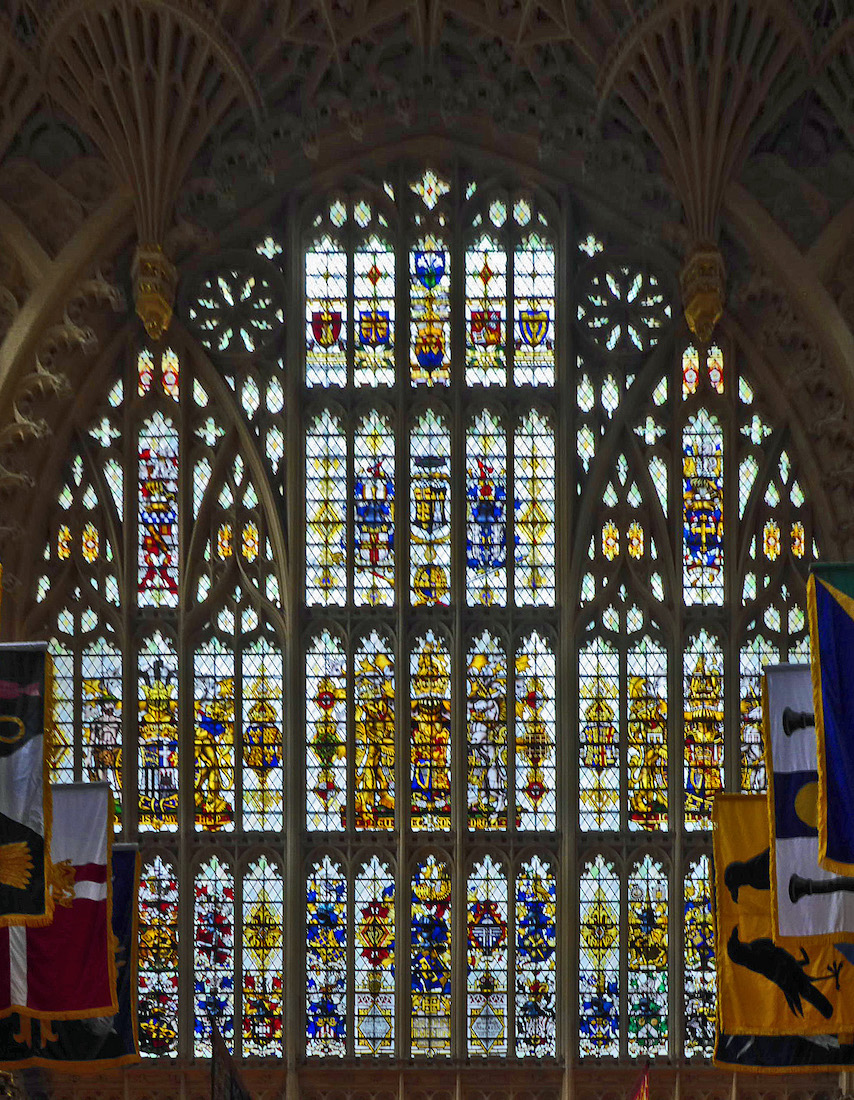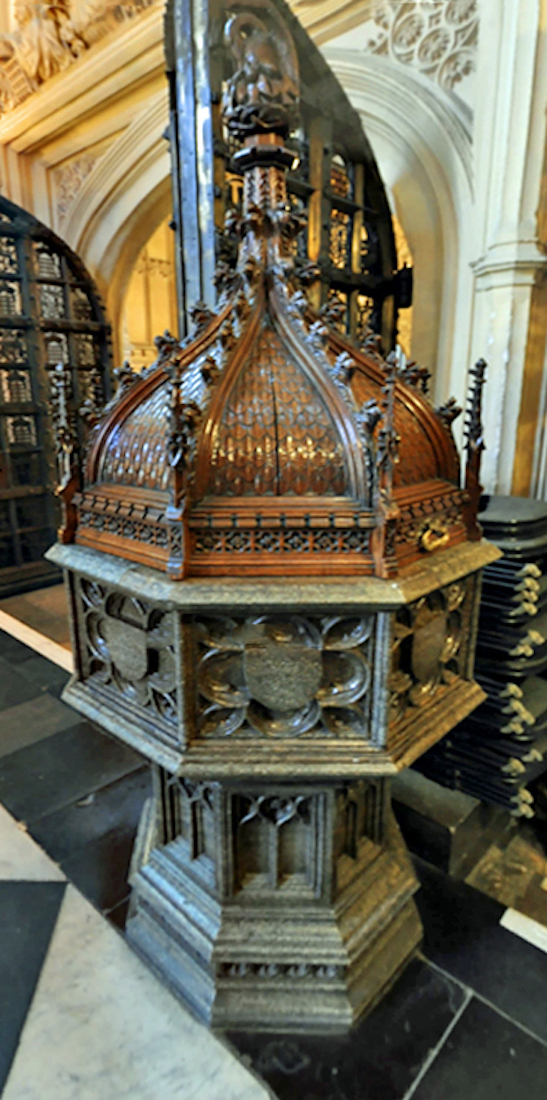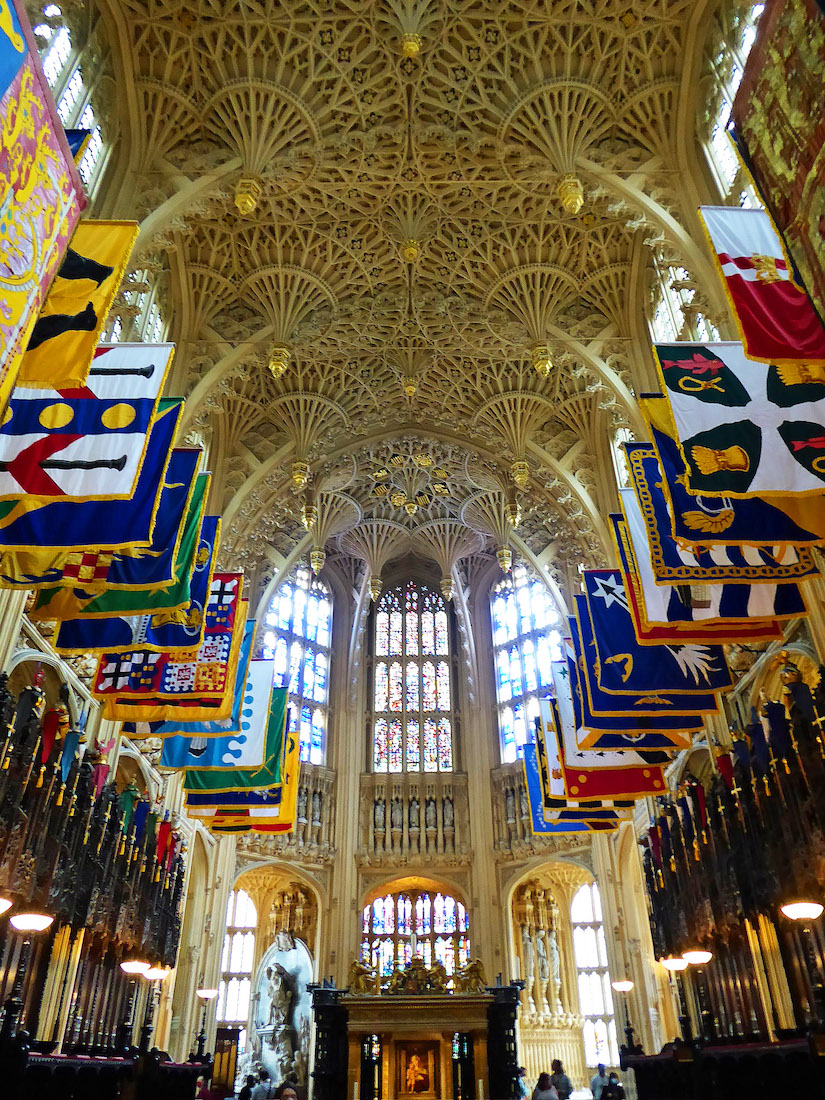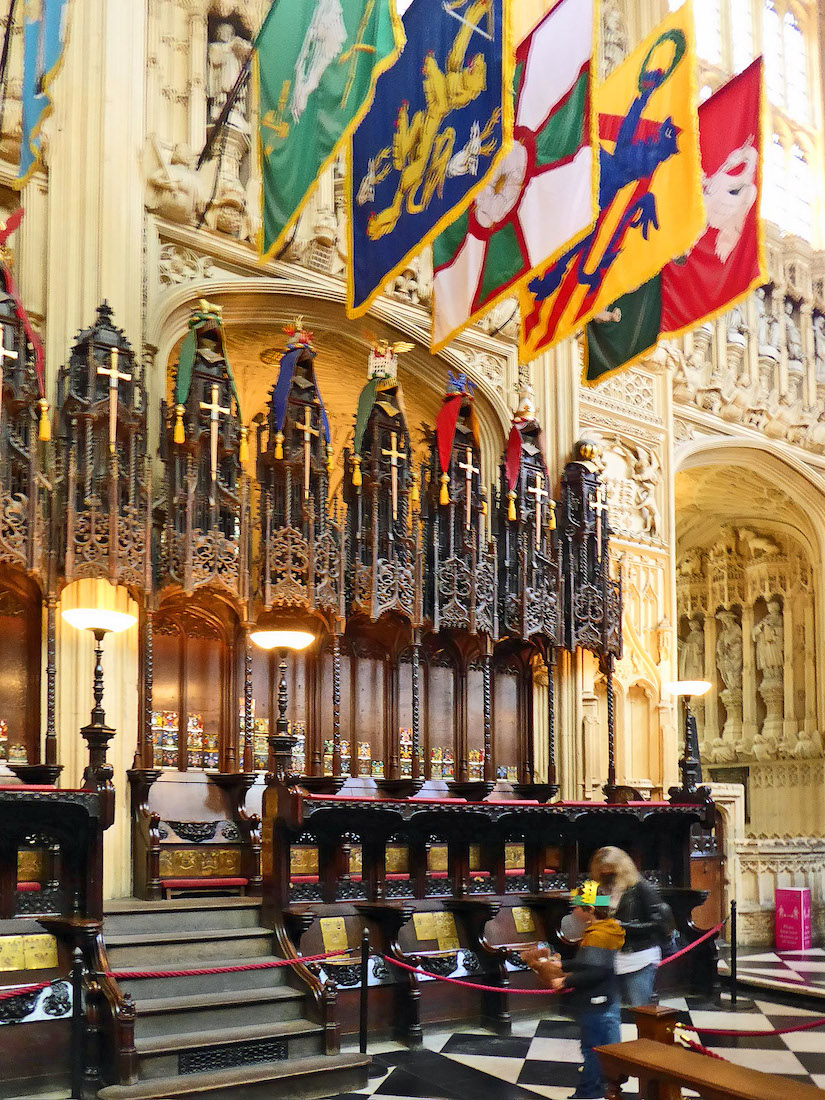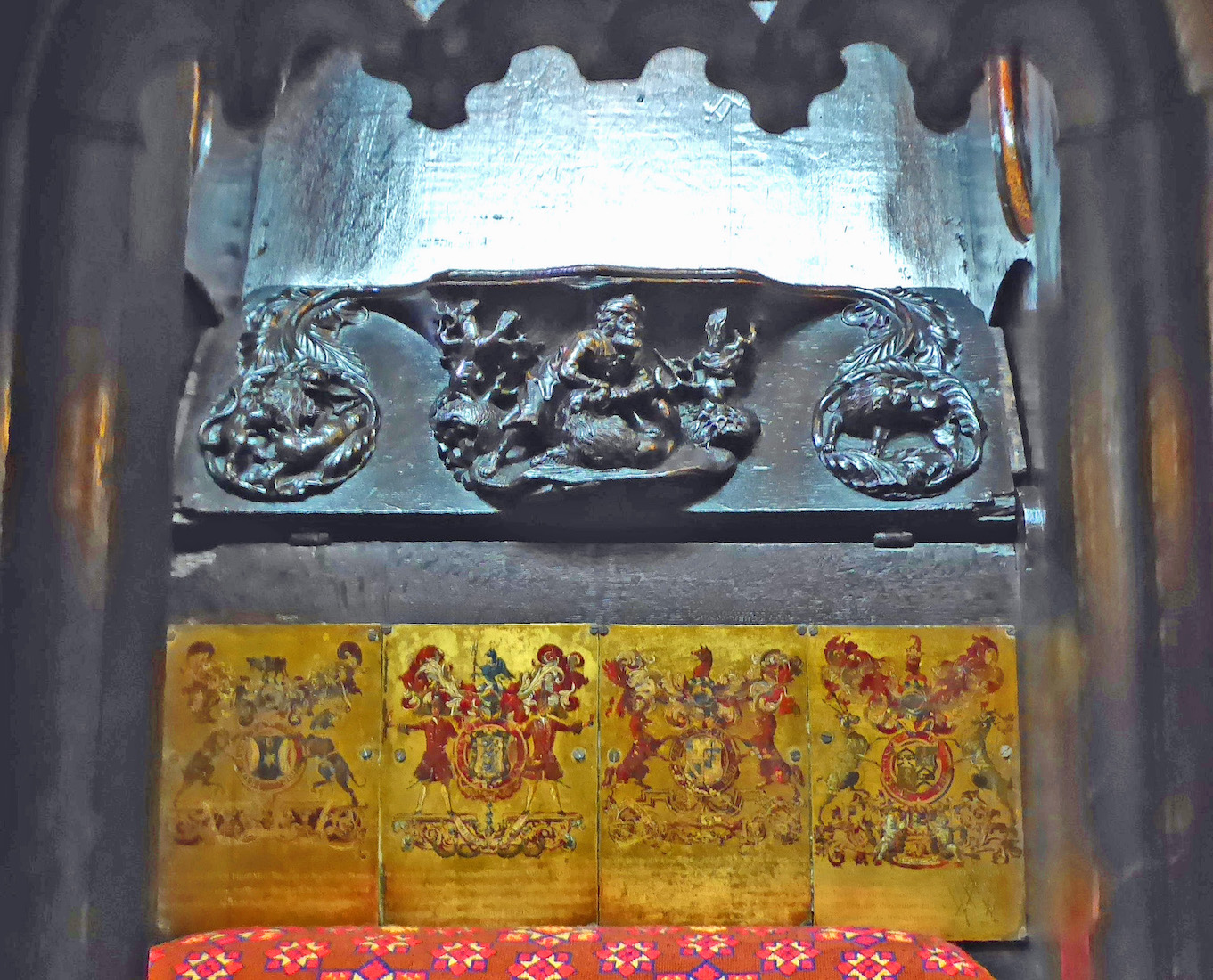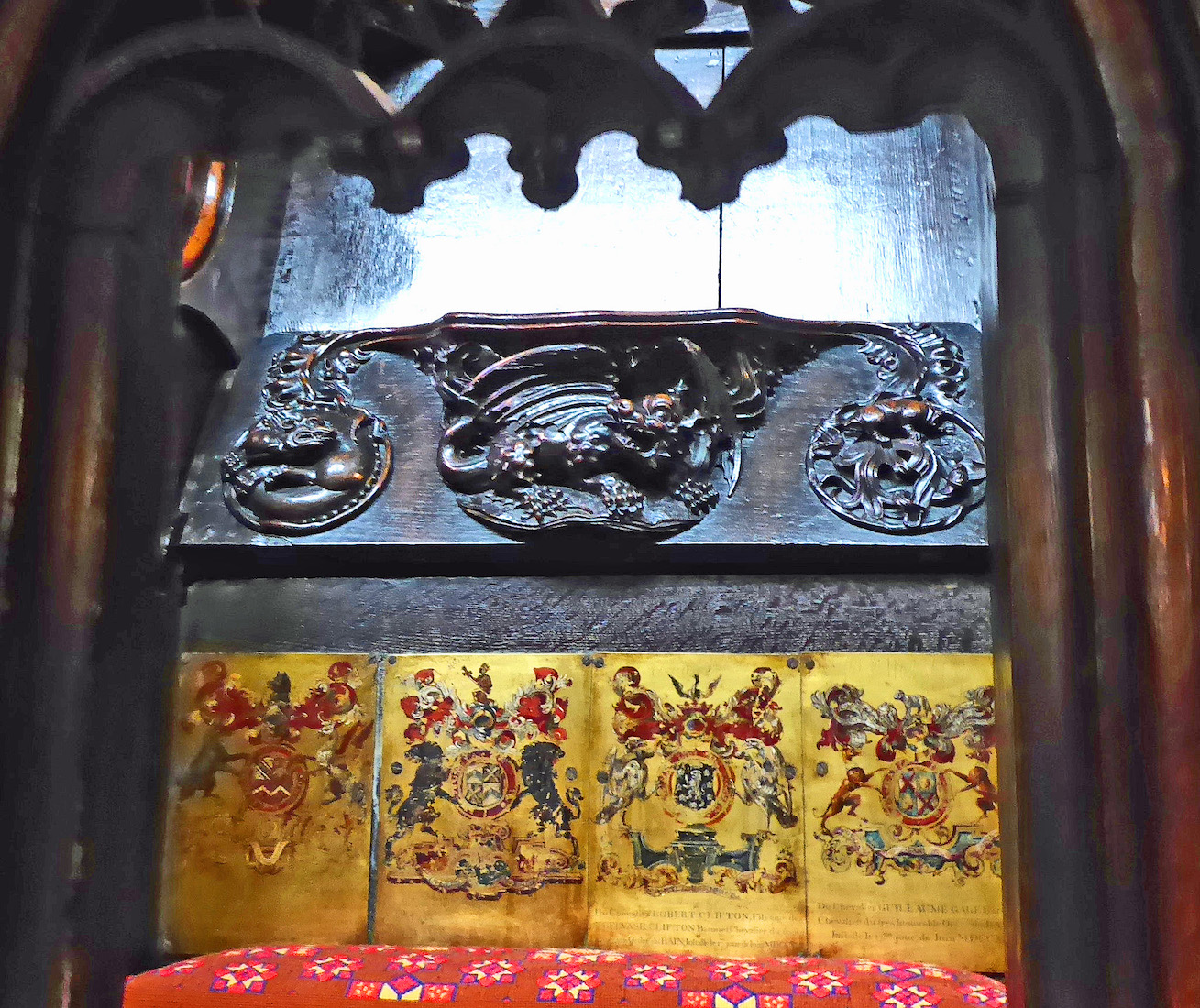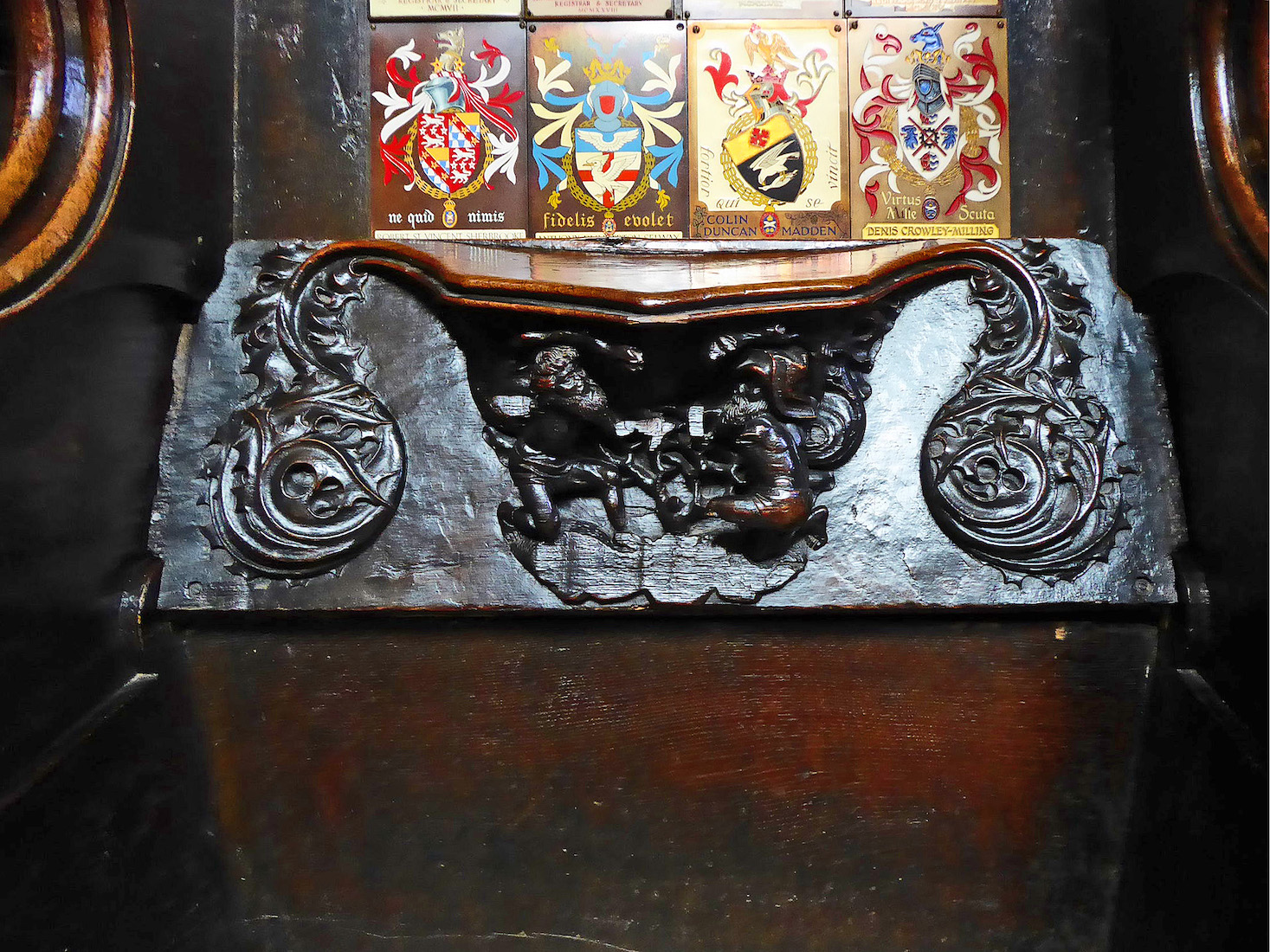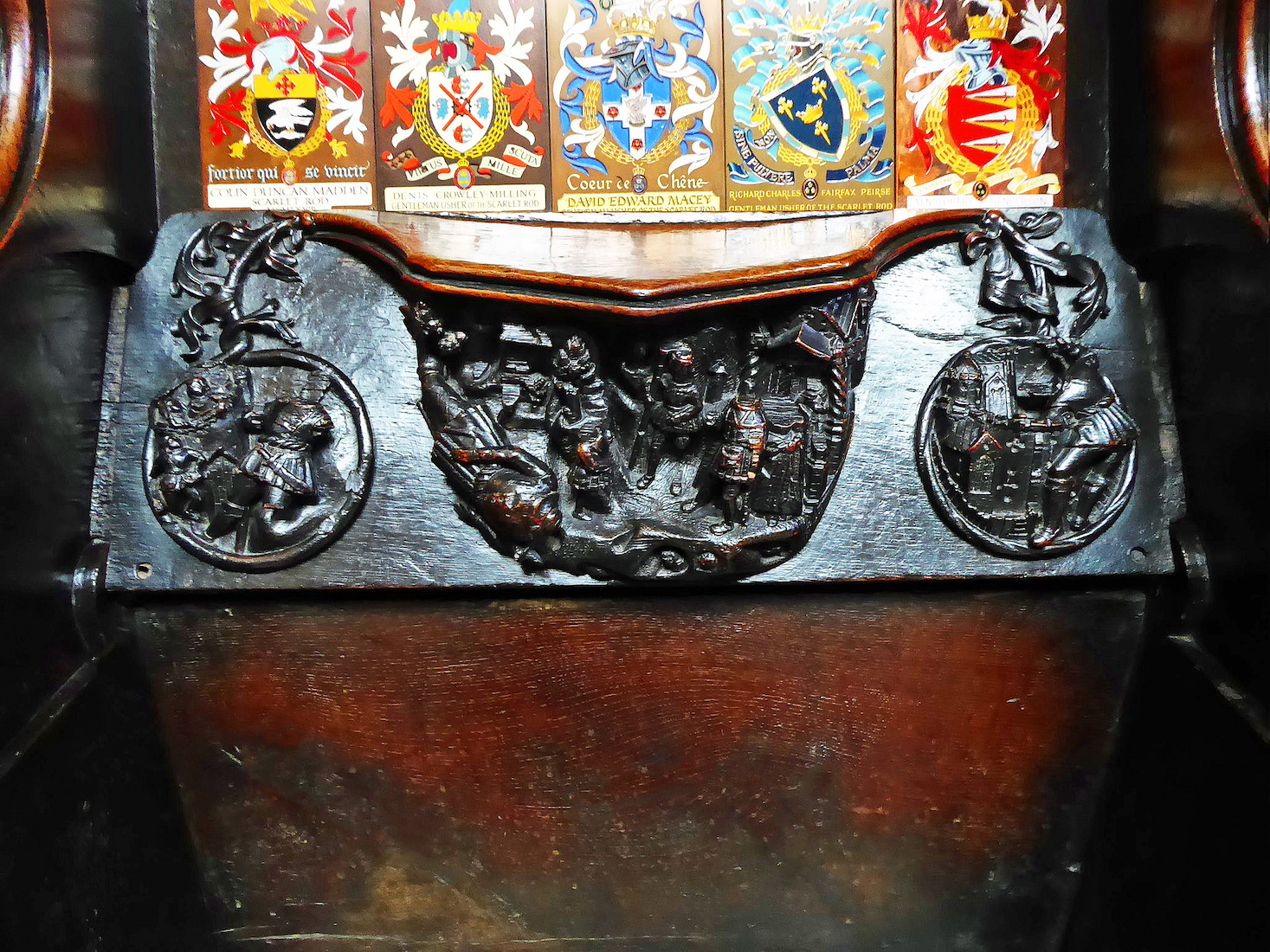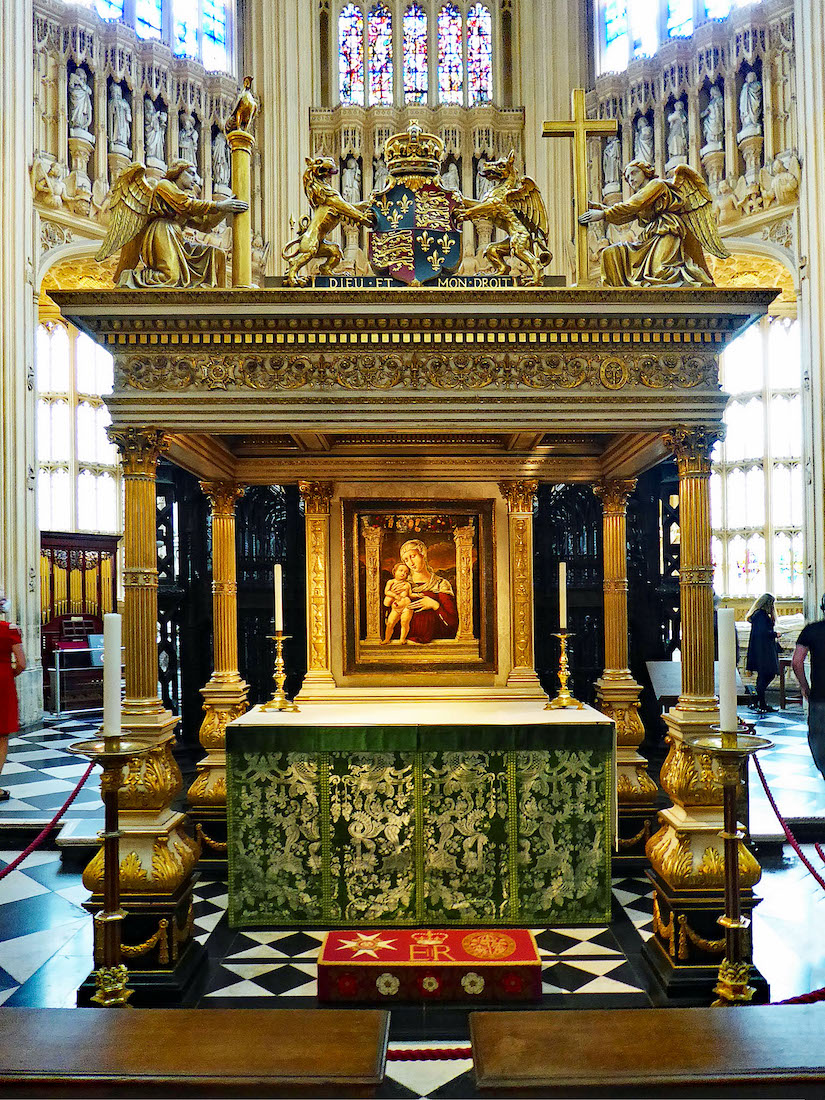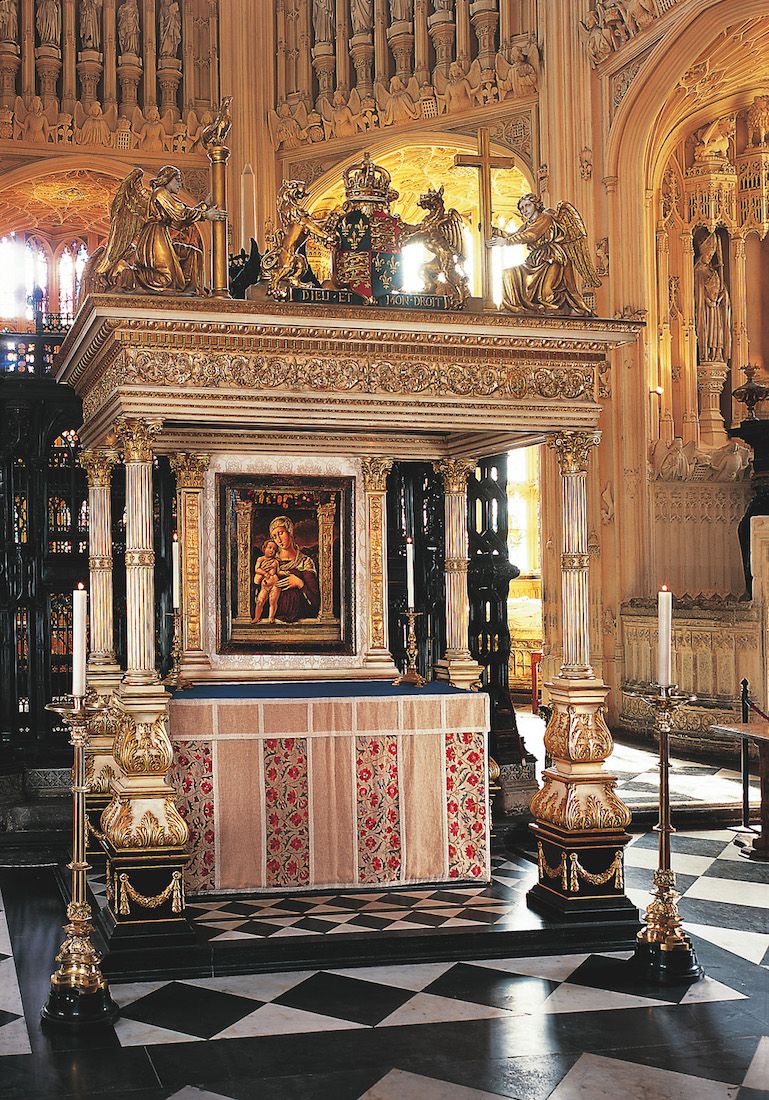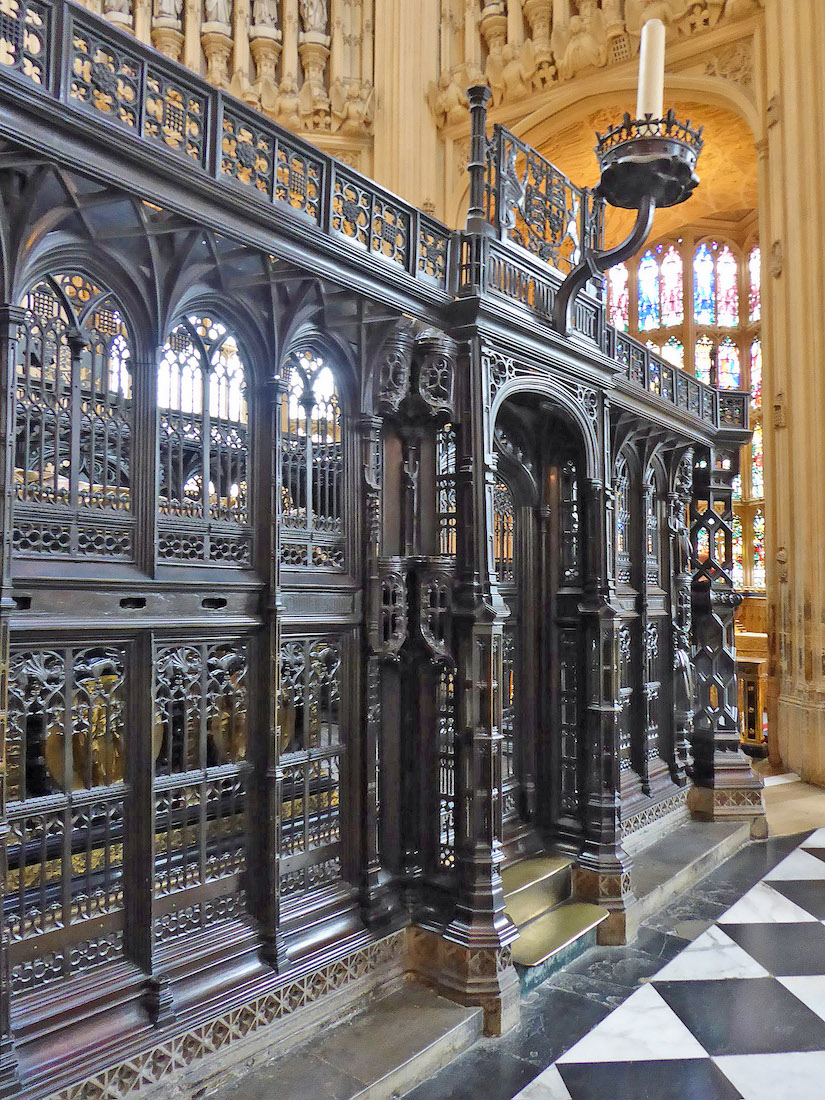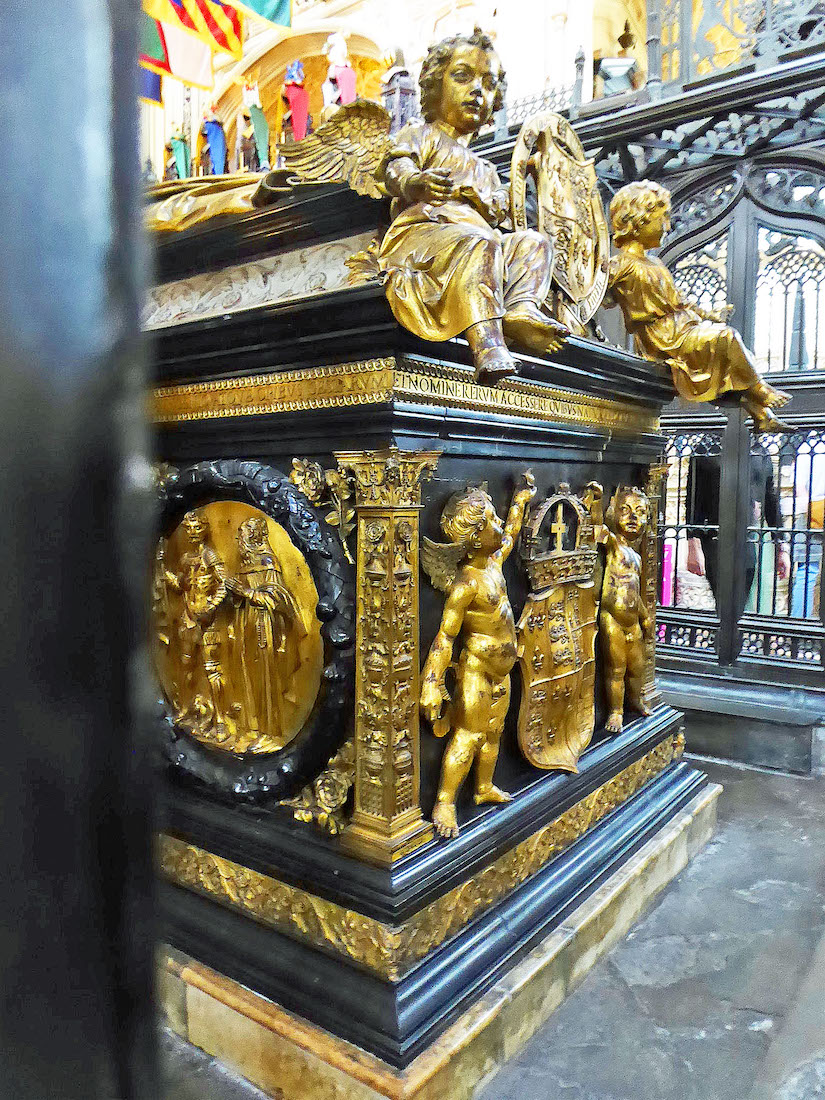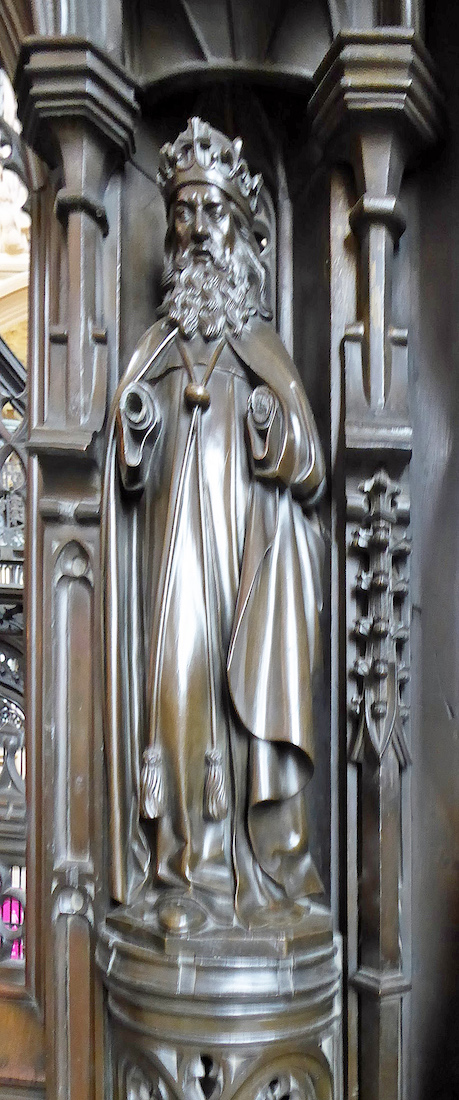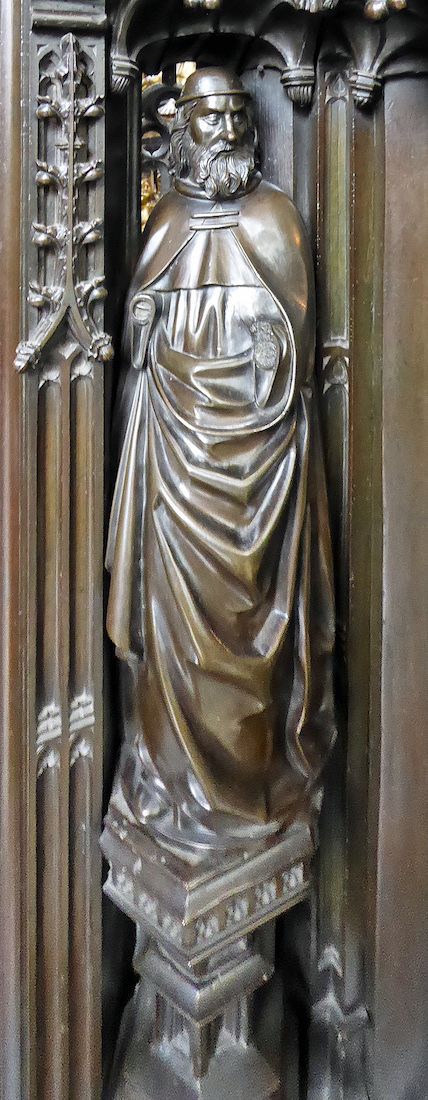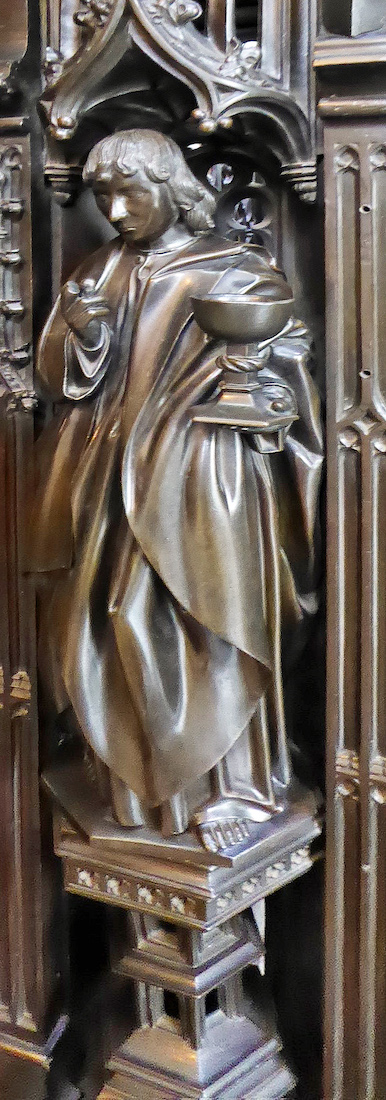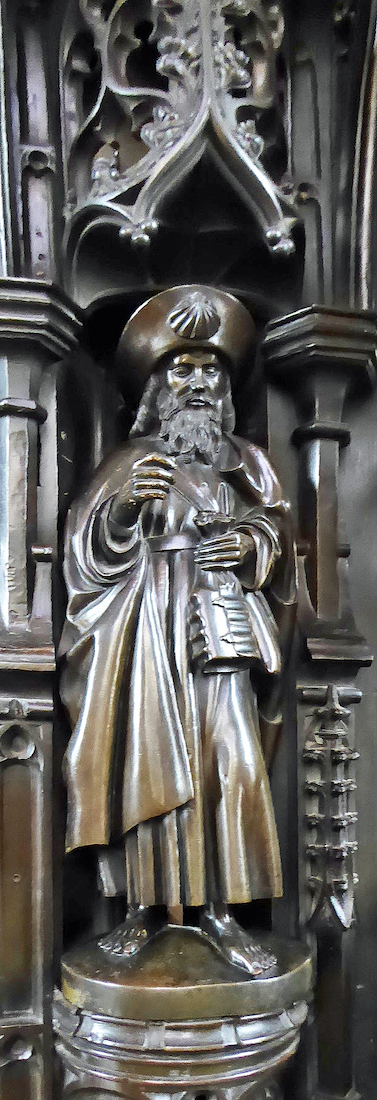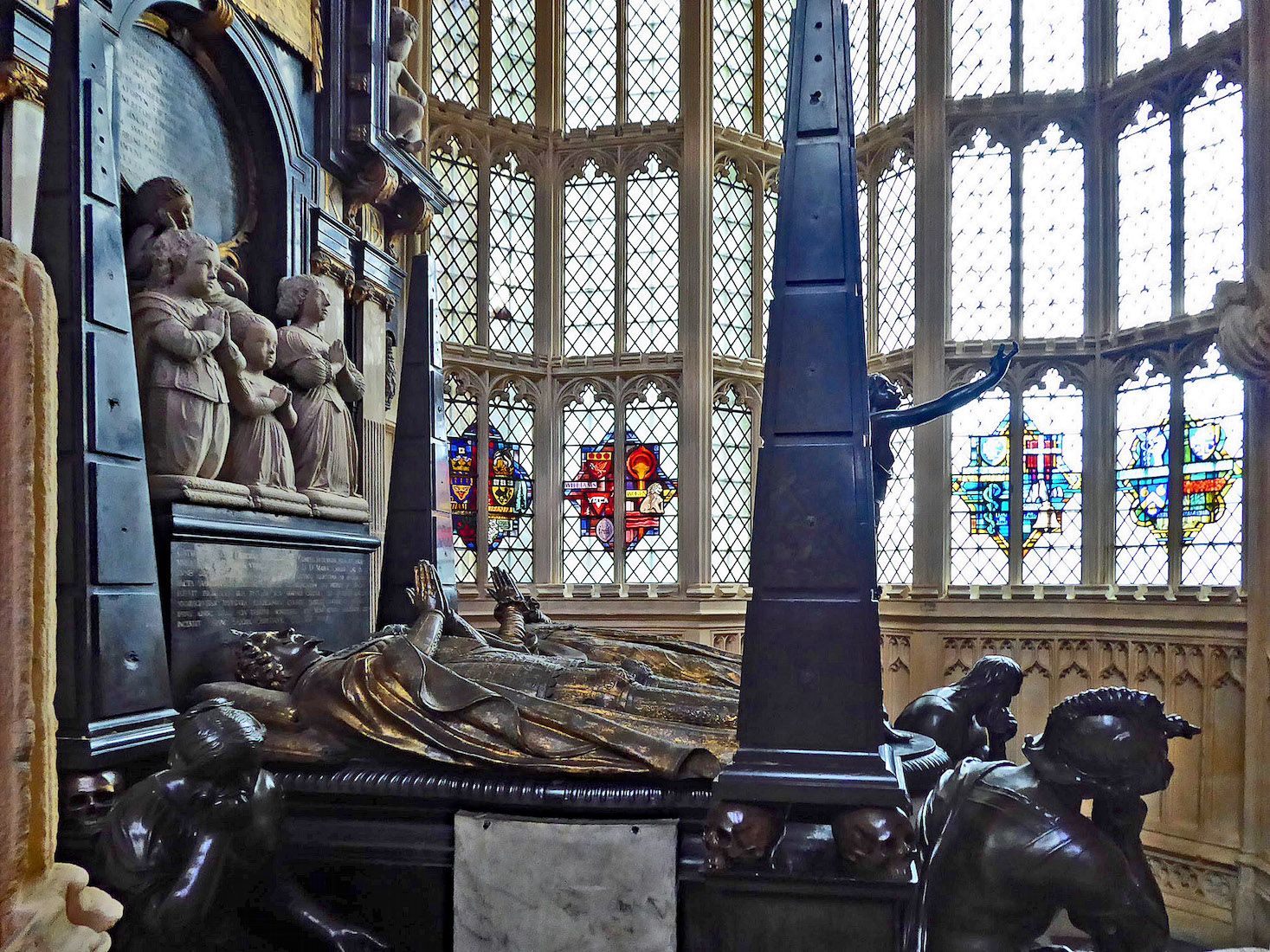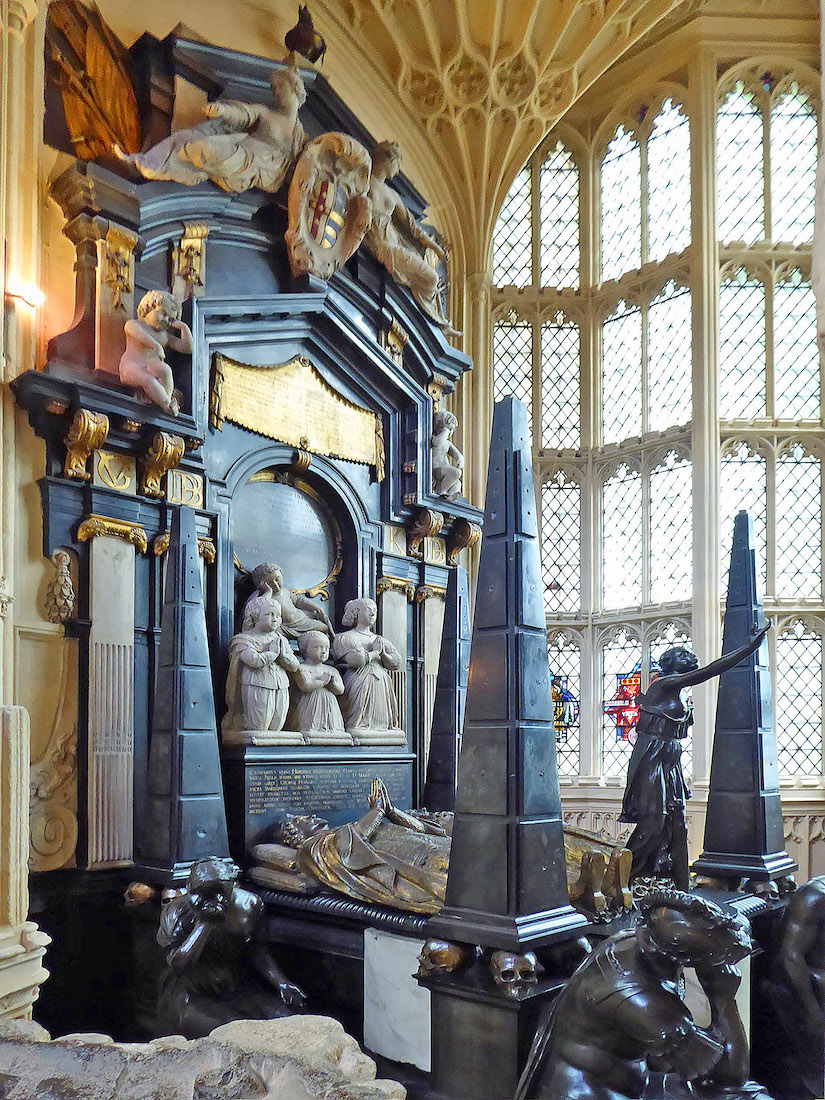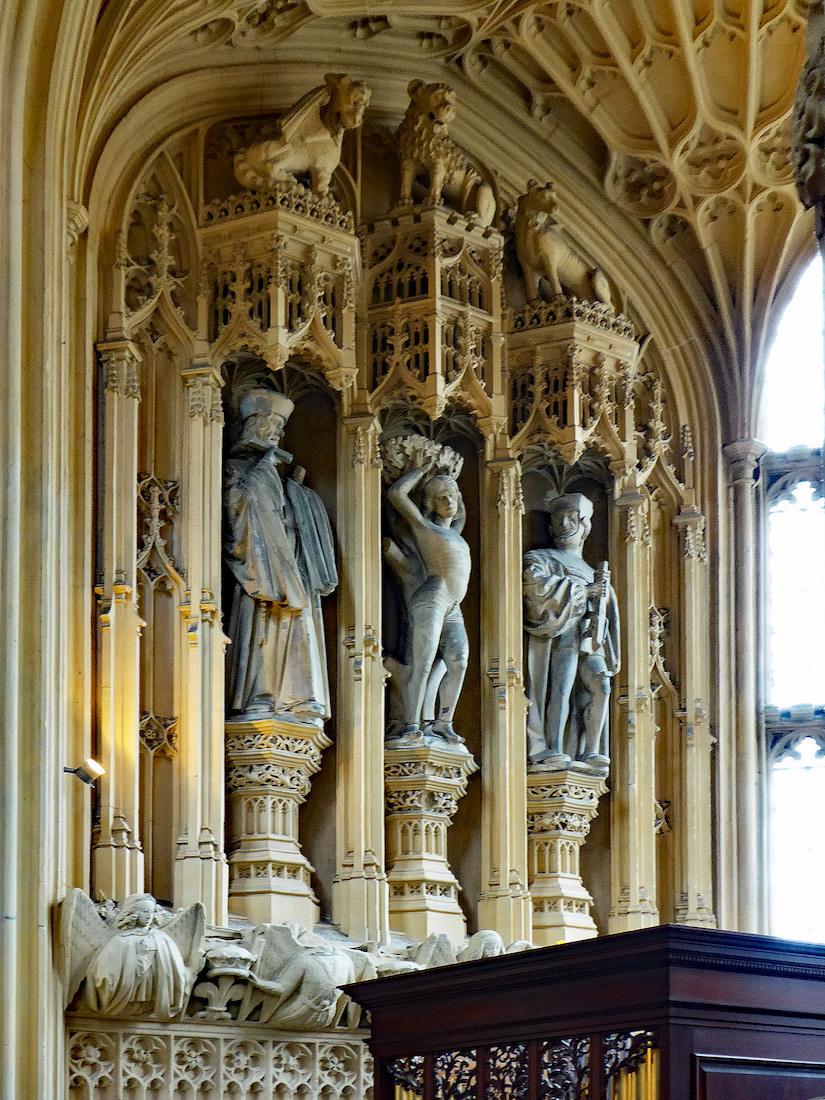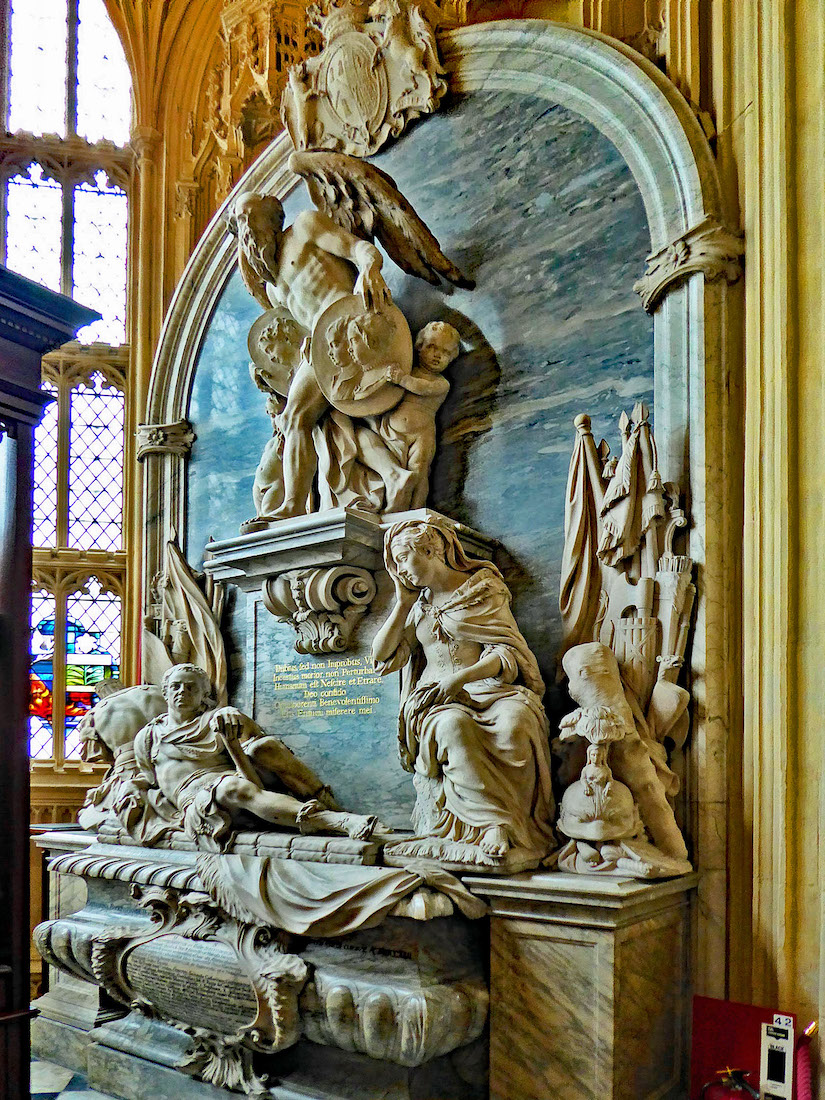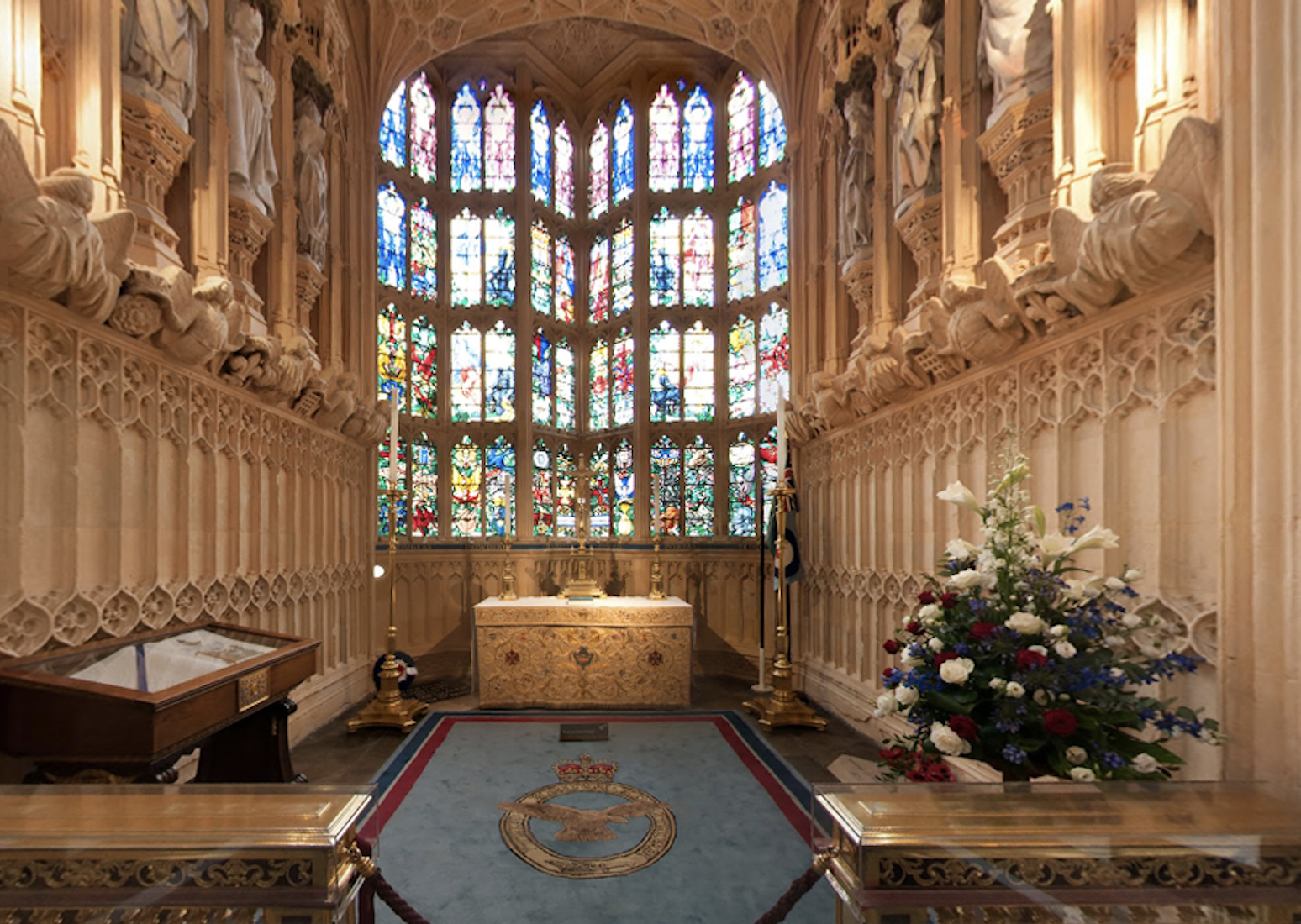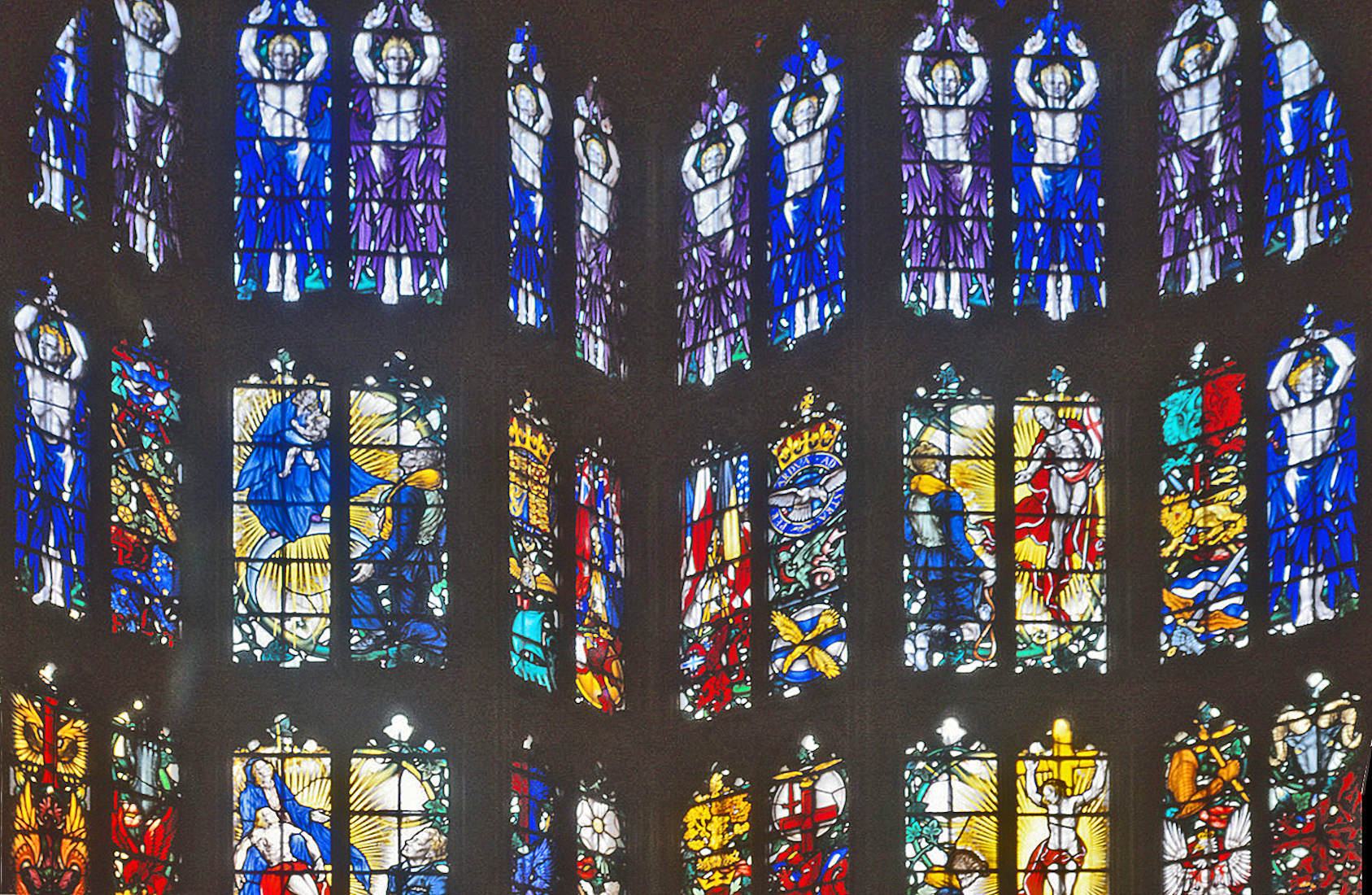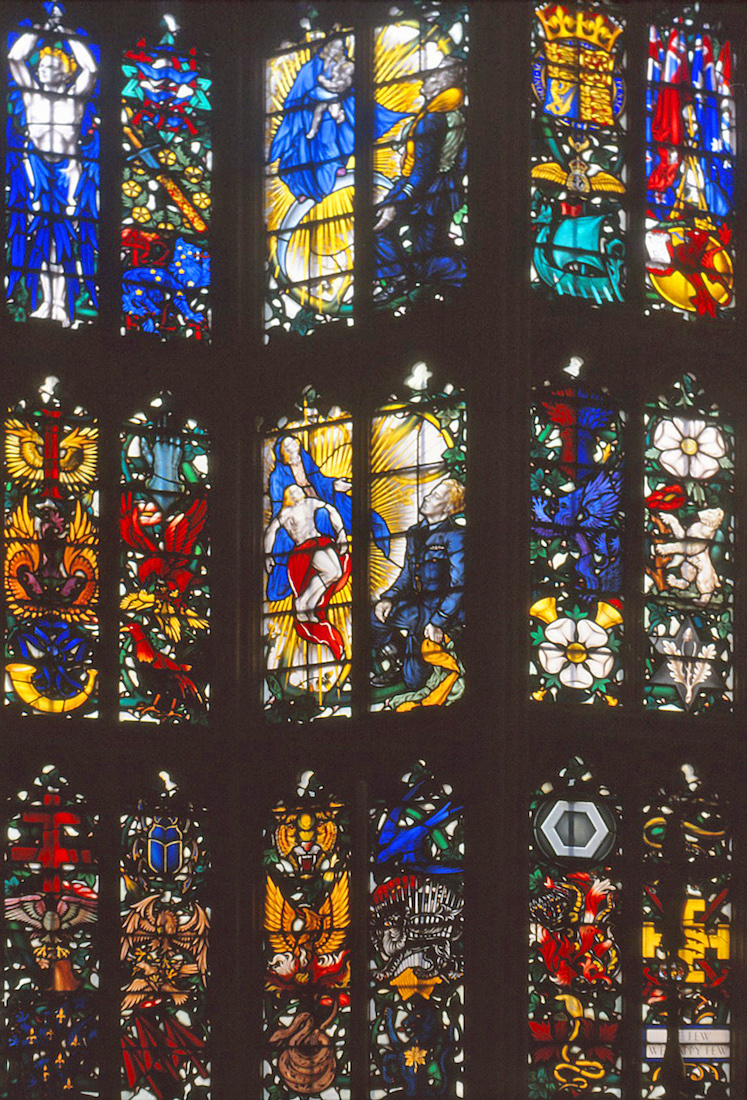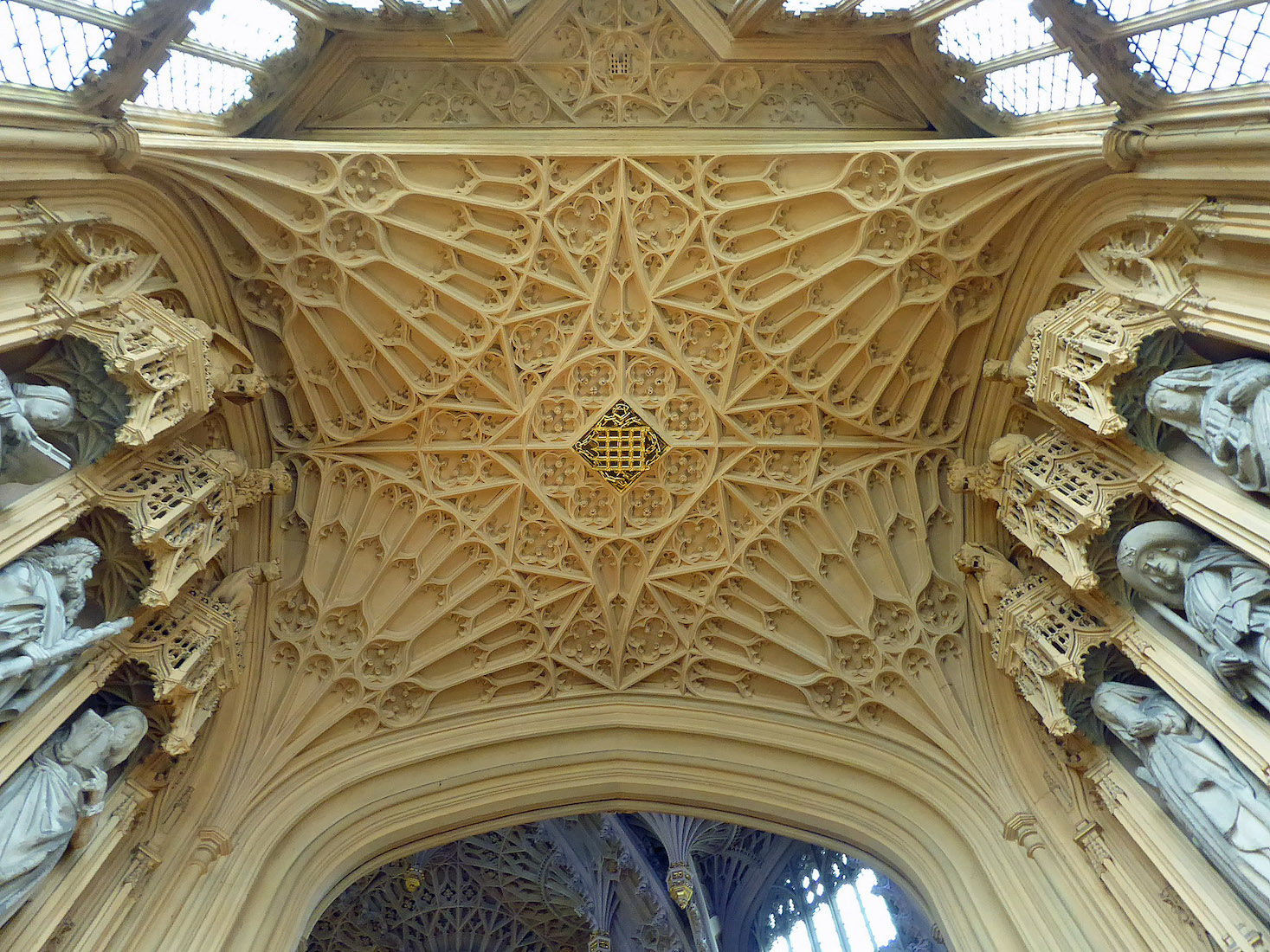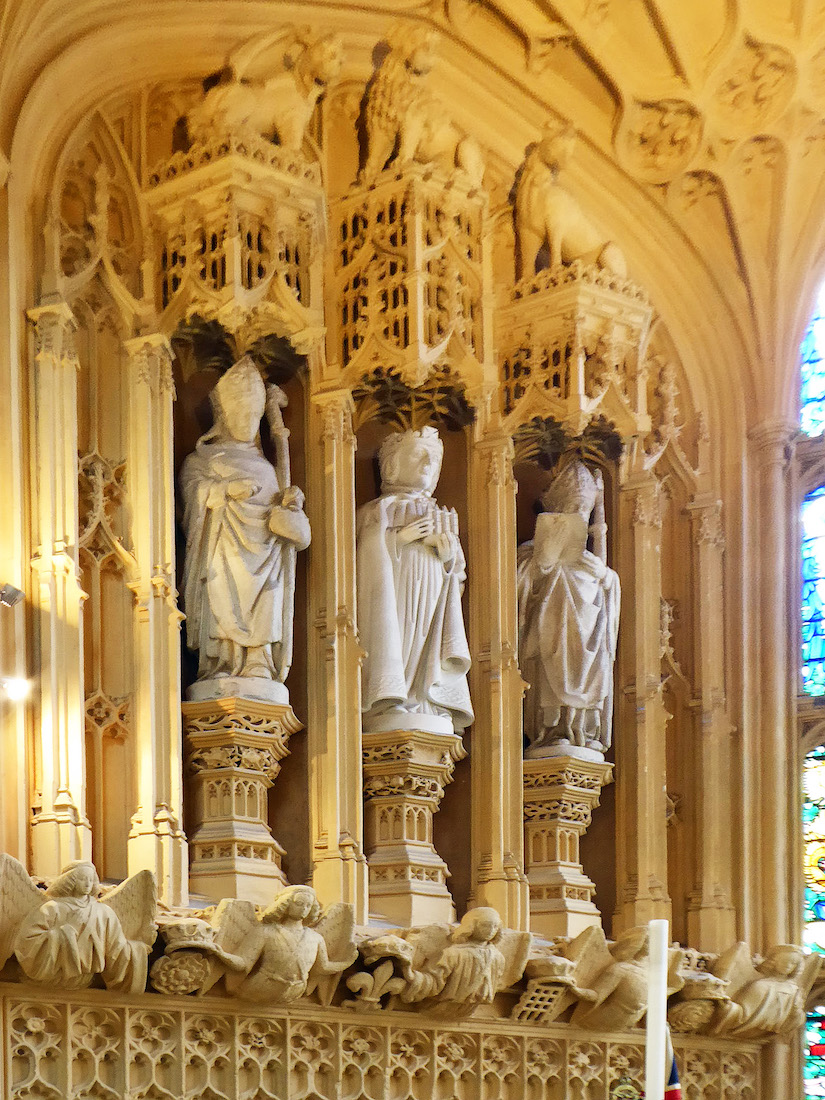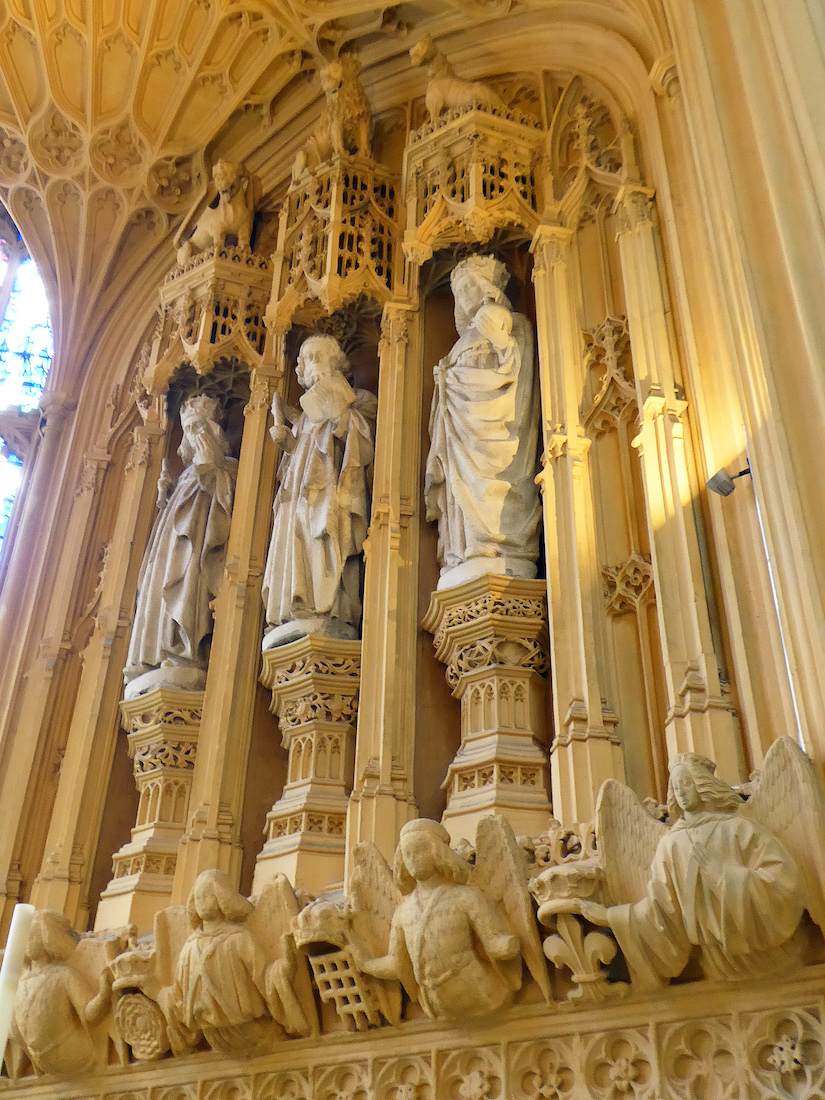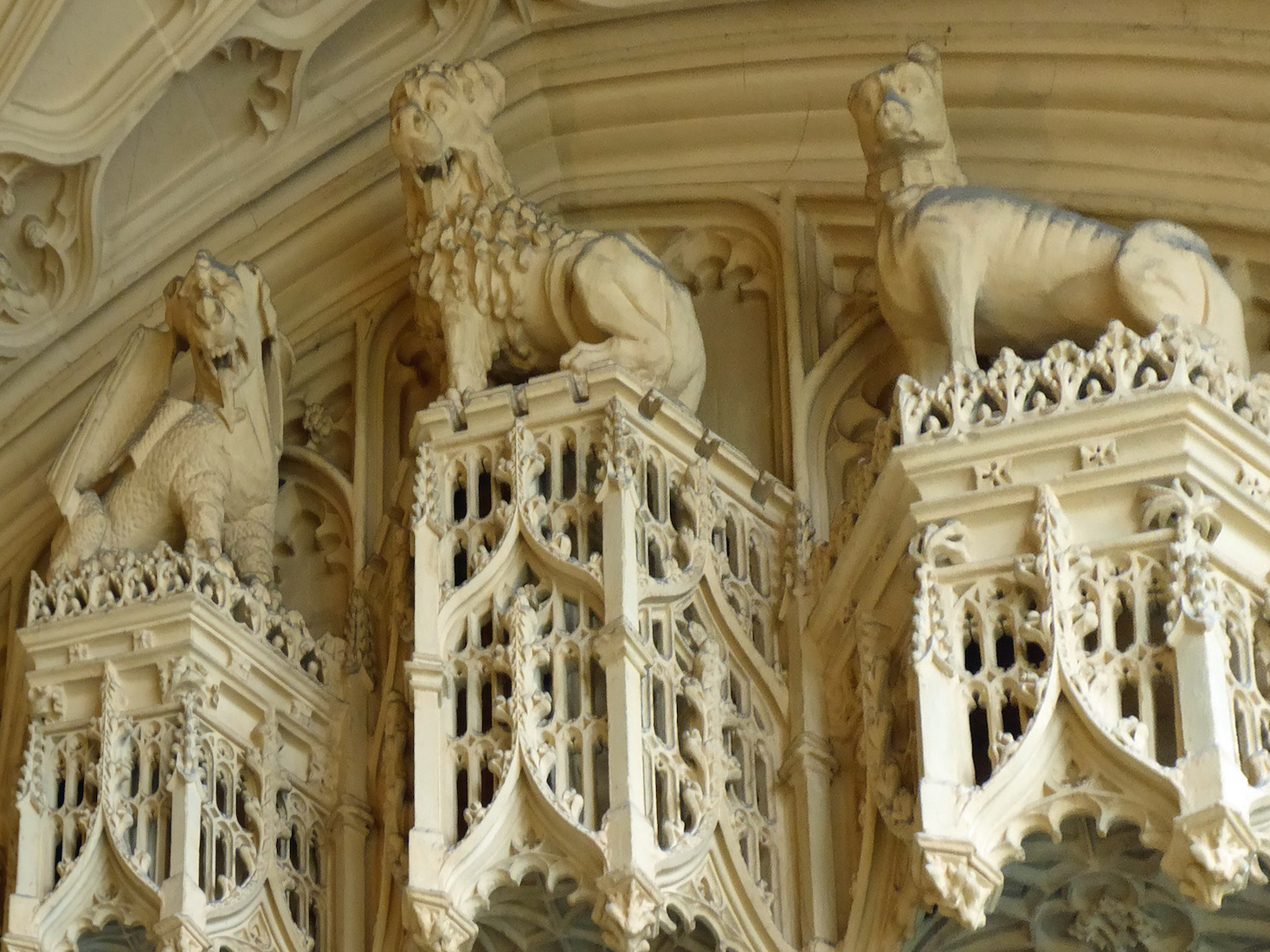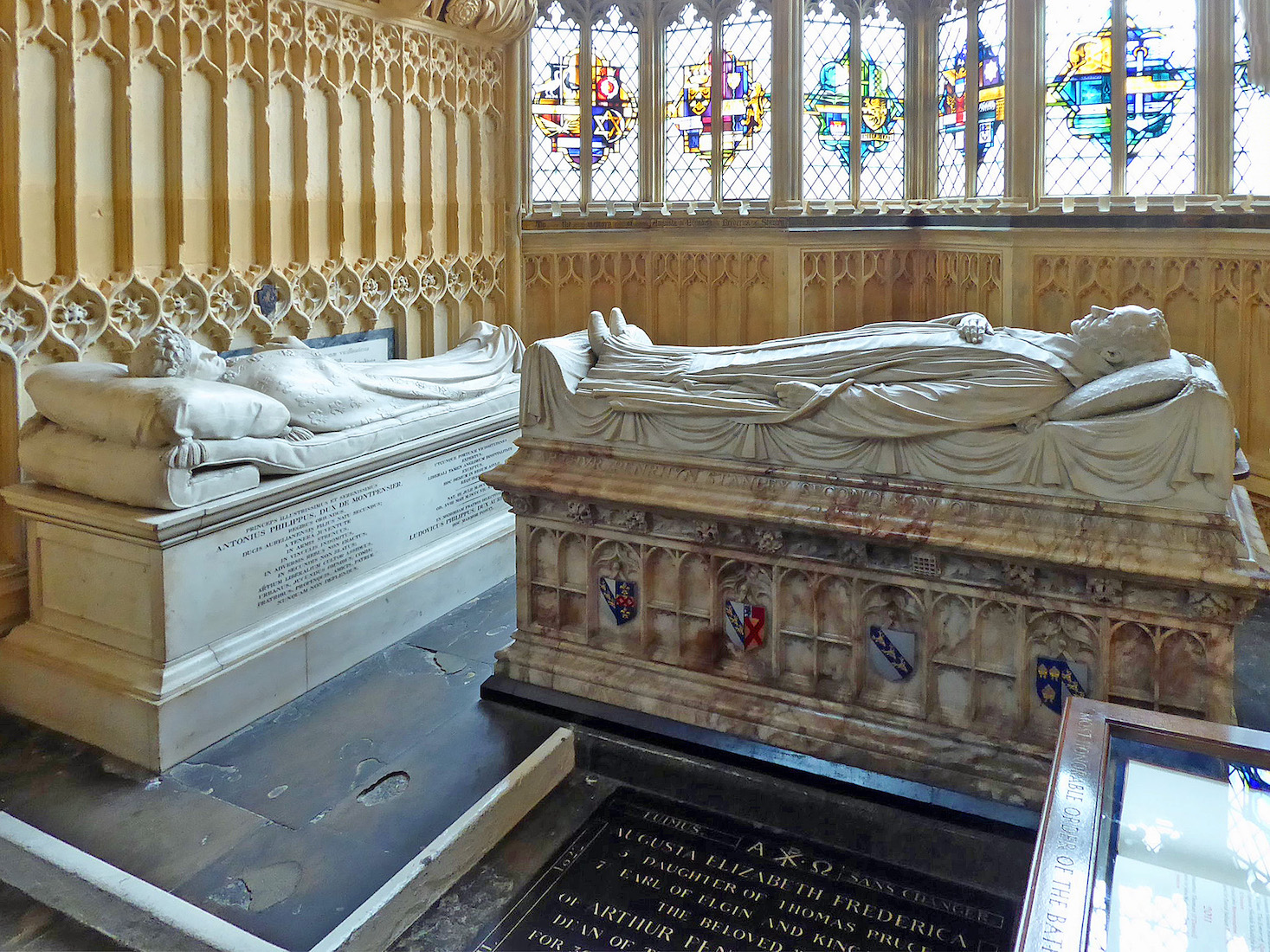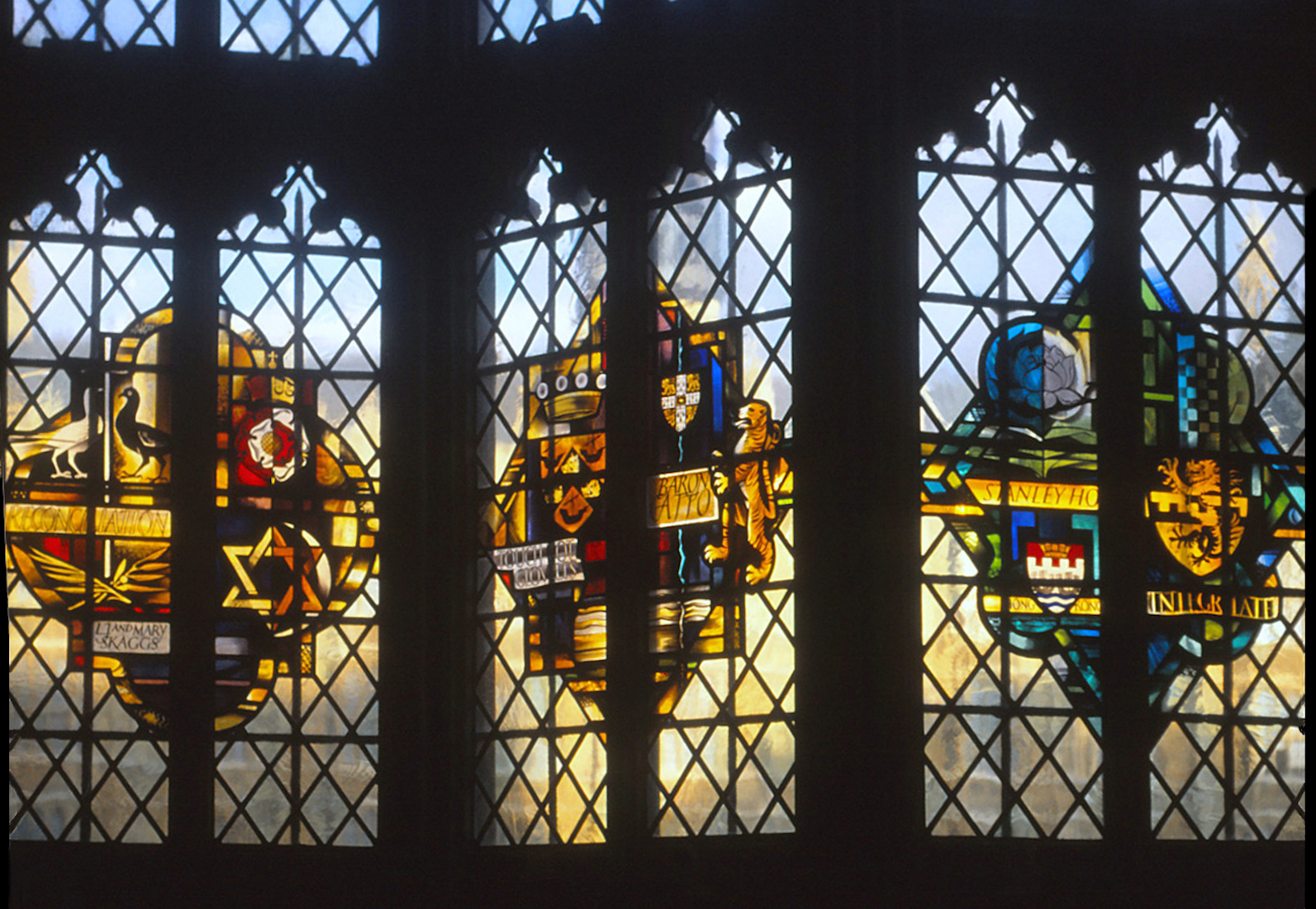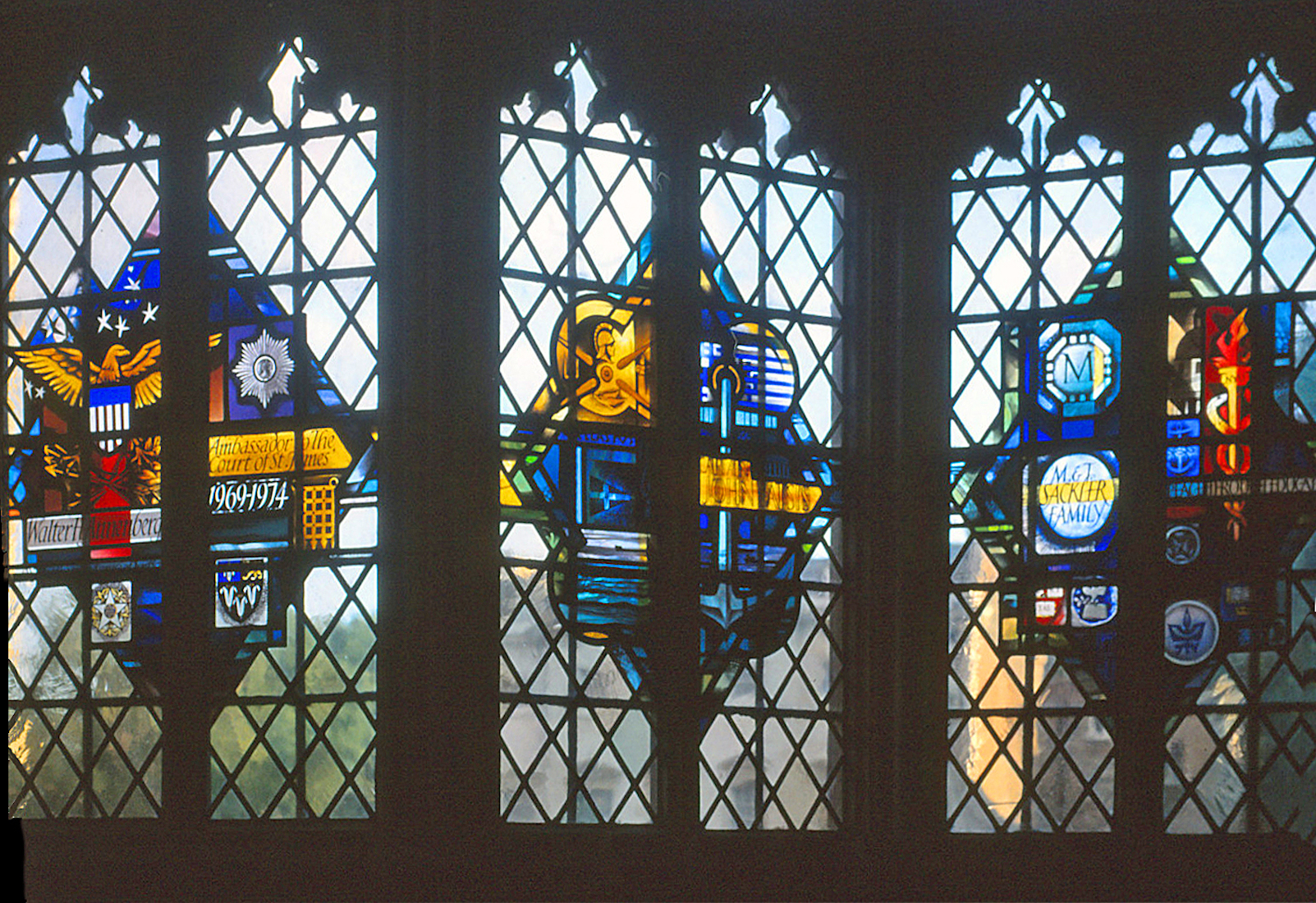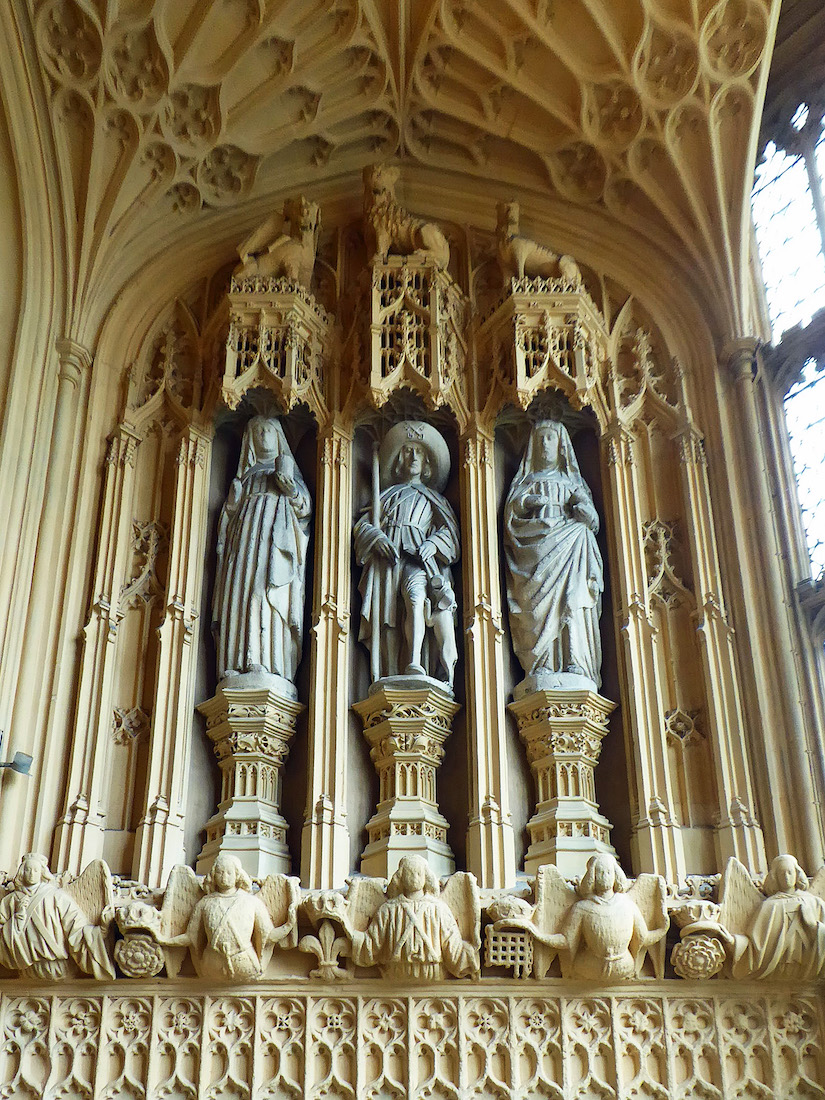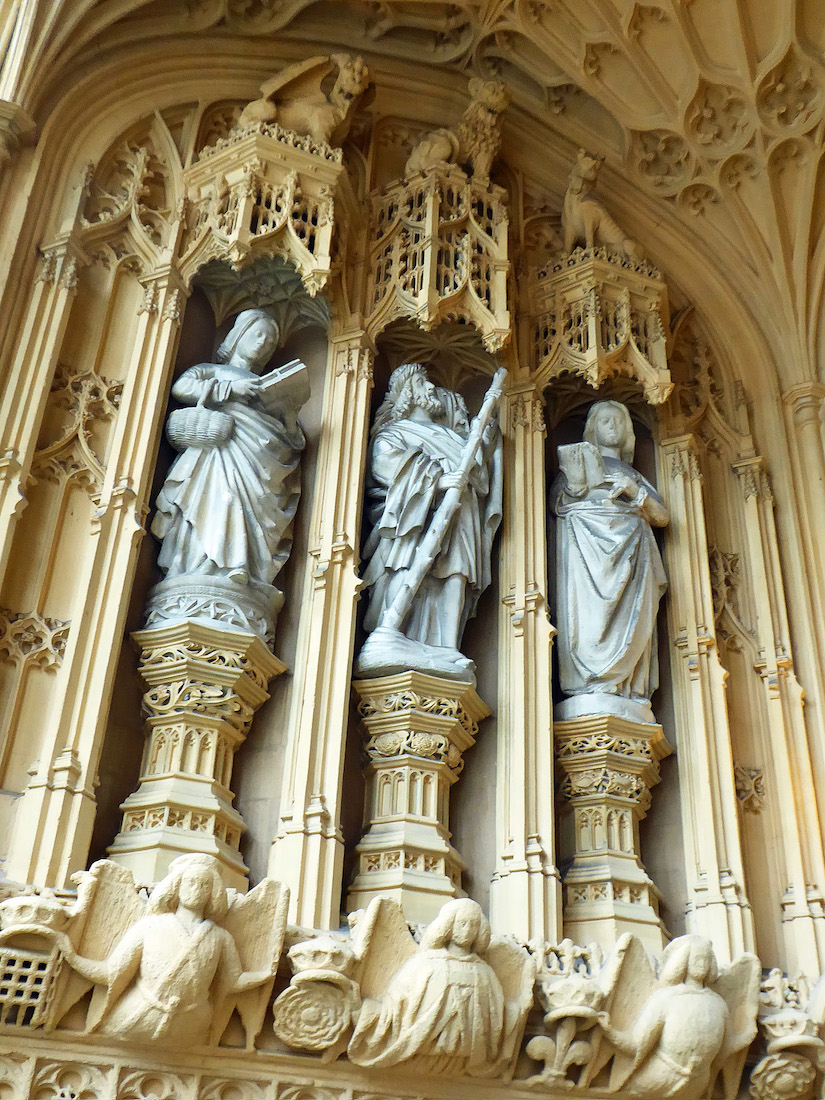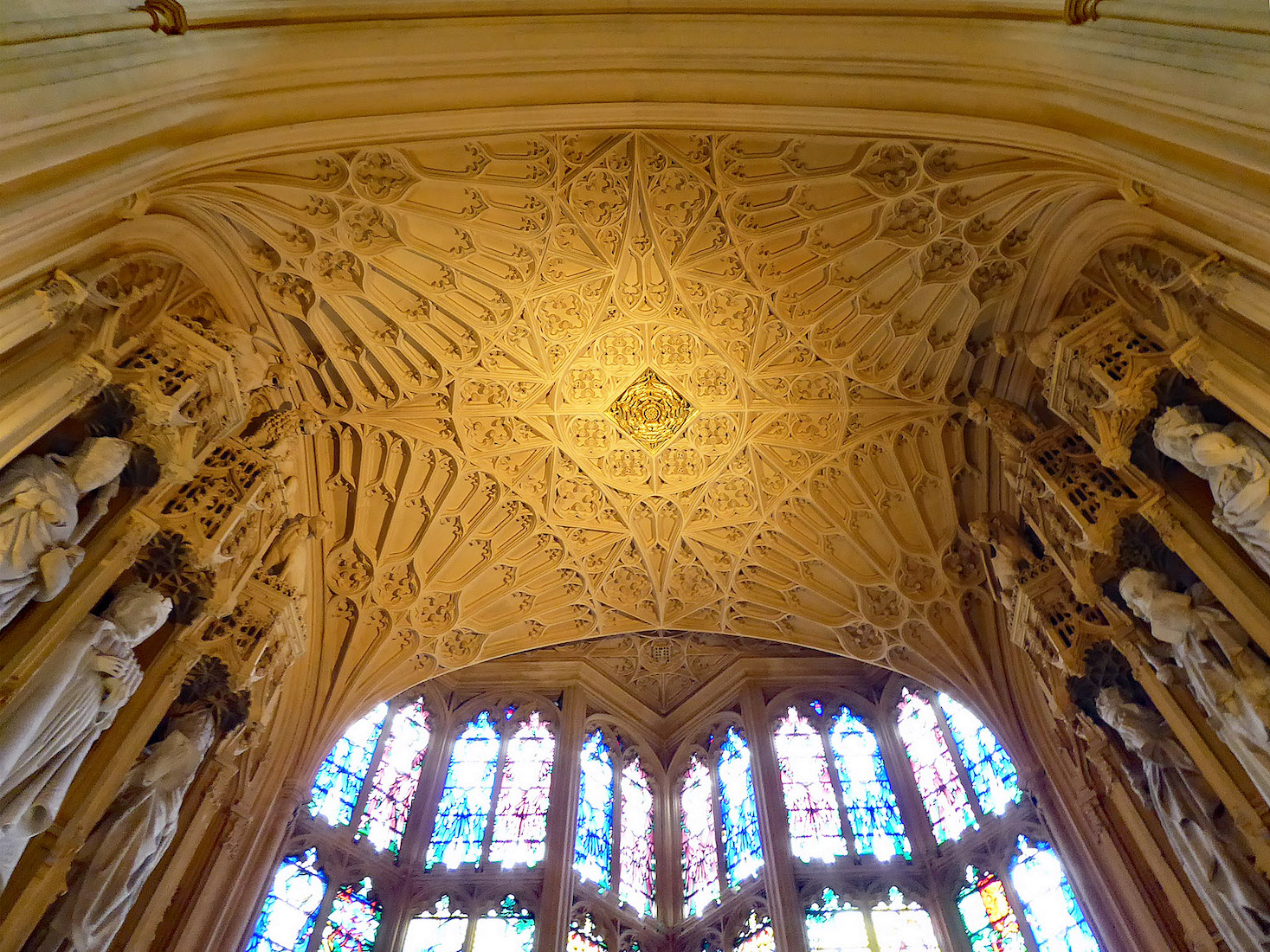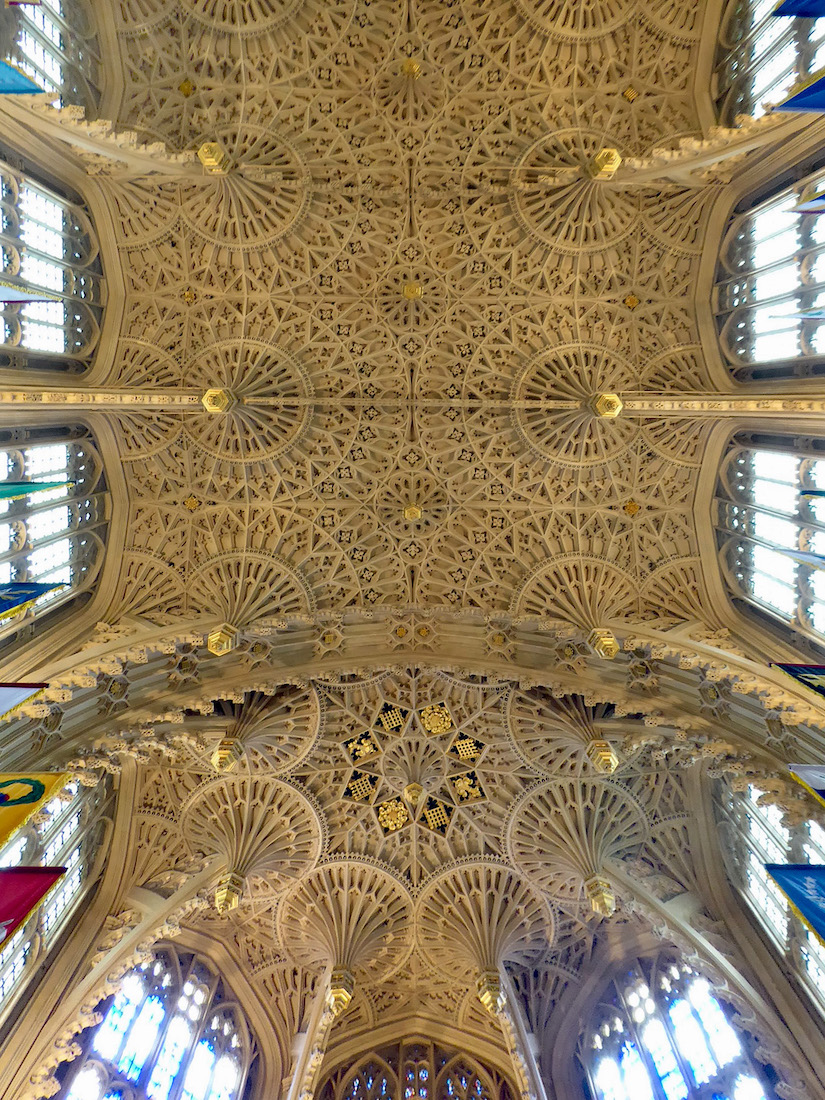
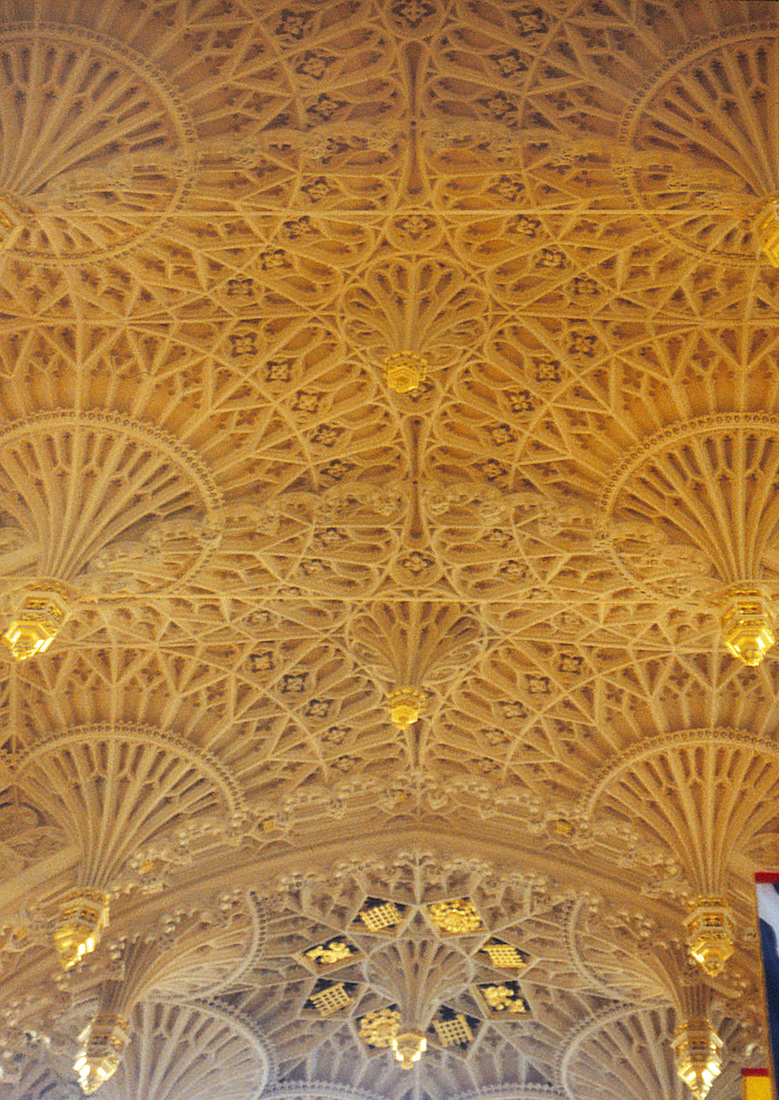
The vaulting of the Lady Chapel is very interesting. Over time, the more traditional fan vaulting was developed to include pendants – hanging features formed by ribs. Here the basic fan vaulting has been actually concealed by the cone shaped pendants. INDEX
G22. WEST WALL AND WINDOW AMT AMT
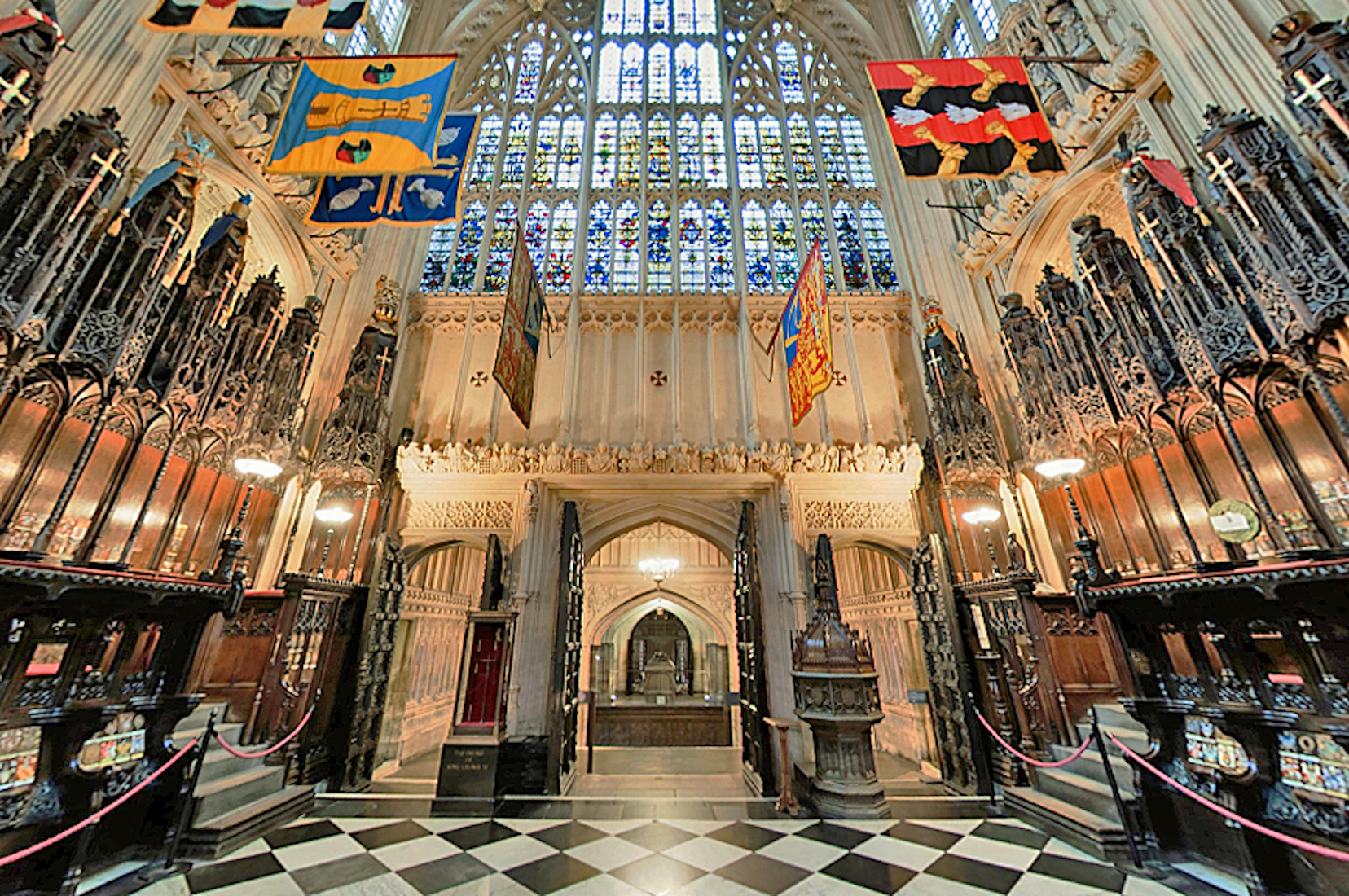

We continue standing in the centre of the Lady Chapel and look backwards to the West wall and window. The baptismal font stands to the right of the central door. In particular notice the frieze of alternating angels and heraldic symbols above the West doors. We shall see this more closely later, as the frieze continues right around the Chapel.
G23. WEST WINDOW AMT
The West window of the Lady Chapel especially honours Sir John Marks Templeton (1912-2008), a very generous benefactor to the restoration of this chapel. The heraldic stained glass window was devised by Donald Buttress, the Abbey Surveyor, with Herbert Chesshyre and designed by John Lawson. The glass was made by Goddard & Gibbs and the window was unveiled by Queen Elizabeth II in 1995 at the completion of the restoration. The coats of arms of the monarch and Philip, Duke of Edinburgh are shown in the centre, with those of King Charles III and the Order of the Bath. The chapel has been associated with the knights of the Bath since 1725 and King Charles III is Great Master of the Order. Also included are coats of arms, cyphers and initials of major donors or those concerned with fundraising. The inscription reads: ‘Sir John Templeton, benefactor. Lord, I have loved the habitation of thy house’.
G24. FONT AMT
Baptism is considered to be the rite of entry into the Christian experience and community, and the font is often placed near the entrance to symbolise this. •• This font is topped with a wooden carving of a pelican pecking at its own breast to feed its young. The pelican is an image of Christ whose self-sacrifice is supreme.
G25. COLOUR AND BANNERS AMT
Since 1725, the Chapel has been used for installations of Knights of the Order of the Bath, and their colourful heraldic banners hang here. The Sovereign and the Great Master of the Order continue to install new knights in the chapel, usually every four years. The banners make a spectacular display.
G26. KNIGHTS’ STALLS AMT AMT
The stalls are not in fact quire stalls, although presumably that was their original purpose. They are better described as ‘knights’ stalls’. They date from different times; while some are original others were added later to accommodate the increasing number of Knights of the Order of the Bath. The stalls were designated for all living Knights of the Most Honourable Order of the Bath. When a knight was installed, he received a stall that was subsequently adorned with his crest, coat of arms, and heraldic banner, the last of which remained in the chapel even after the knight's death. These banners all remain to decorate the chapel. During the nineteenth century, there were too many knights to accommodate in the chapel and no more were installed until the twentieth century. Currently, only the most senior knights are assigned stalls in the chapel.
G27. MISERICORDS AMT (x4)
Westminster Abbey has forty 16th century misericords. Originally a misericord was a shelf under the folding seat of a choir stall, which supported a standing monk during a long service. Misericords were often elaborately carved, and the subjects varied from spiritual to profane! Four of the Abbey misericords are pictured above. For a full list see: https://www.misericords.co.uk/westminster.html
G28. CHAPEL ALTAR AMT AMT
The Lady Chapel has a simple altar with frontal, cloth and two candles. Two further candles stand in front at the sides. The painting of the Virgin and Child behind the altar is by Bartolomeo Vivarini (Venetian School, about 1480). It was presented to the Abbey in 1935.
G29. TOMB OF HENRY VII AMT AMT
Behind the altar stands the magnificent tomb of Henry VII and his wife Elizabeth of York. The couple are buried in a vault under the floor beneath the tomb. The black marble tomb base is adorned with six medallions in copper gilt representing the Virgin Mary and Henry's patron saints (Michael, George, Anthony, Christopher, Anne, Edward the Confessor, Vincent, Barbara, Mary Magdalene, John the Baptist and John the Evangelist). At either end are coats of arms supported by cherubs.
G30. TOMB FIGURES AMT (x4)
The grille around the tomb is by Thomas Ducheman (who most likely also designed the bronze gates to the Chapel). Only six of the thirty two statues in the niches of the grille now remain (shown above Saints Edward the Confessor, Unknown, John the Evangelist, James the Great), George, and Bartholomew.
G31. APSIDAL CHAPEL N1S: VILLIERS MONUMENT AMT AMT
Radiating out from the East end of the Lady Chapel are five apsidal chapels. For convenience we label them North to South by N1S, N2S, ... N5S. This first chapel, N1S, is almost completely taken up with the Villiers Monument. This monument to George Villiers, 1st Duke of Buckingham (d.1628) and his wife Katherine Manners (d.1649) is by Hubert Le Sueur. His duchess Katherine erected the large monument of black and white marble and bronze in 1634. Her effigy is shown beside him but she was actually buried at Waterford in Ireland (died 1649). The gilded bronze effigy of the Duke shows him in monogrammed plate armour and she is shown in an embroidered dress, ruff, and mantle, both wearing coronets. At their feet is a figure of Fame although it has lost its trumpet. At each corner is a black marble obelisk supported on four skulls with bronze mourning figures of Pallas, Benevolence, Neptune and Mars.
G32. APSIDAL CHAPEL N2S AMT AMT
A small transportable pipe organ occupies this chapel space. There are statues on the left (West) wall, and a monument on the right wall. The statues depict the martyrdom of St Sebastian. St Sebastian is shown tied to the tree flanked by his executioners (surprisingly given equal prominence as the saints in order to form a tableaux across the niches). •• Opposite is the Duke of Buckingham Monument, remembering John Sheffield, Duke of Buckingham (d.1721). The monument is by Laurent Delvaux & Peter Scheemakers. Sadly the monument blocked three niches which probably contained fine statues ... .
G33. AXIAL CHAPEL N3S: RAF CHAPEL AMT
The next chapel, the RAF Chapel, aligns with the axis of the Abbey. It is a fine chapel with interesting stained glass windows, vaulting above, statues in side niches, and an altar with cross and candles. We get a good look at the side angel friezes here. The chapel is dedicated to the men of the Royal Air Force who died in the Battle of Britain between July and October 1940. This chapel received damage from bombs which fell in that year. The Tudor glass in the window was also blown out at the same time. The chapel was unveiled by King George VI on 10 July 1947.
G34. BATTLE OF BRITAIN MEMORIAL WINDOW AMT AMT
There is much detail in this window by Hugh Easton, but we might find the following. In four panels are shown visions which symbolize the Redemption. In one a squadron leader kneels before the Virgin Mary and the Christ Child. Below this she is represented in her sorrow with the dead Christ across her knees (a symbol of the sacrifice of the mothers and widows of those who died in the conflict). On the opposite side a panel shows a sergeant pilot kneeling before the Crucifixion (a symbol of the sacrifice of the pilot himself). Lastly, above this, is the Resurrection seen by a pilot officer (representing the pilots' triumph).
G35. RAF CHAPEL VAULT AMT
The exquisite vaulting of the Lady Chapel continues into this Chapel.
G36. RAF CHAPEL STATUES AMT (x3)
There are three statues in the walls on either side of the RAF Chapel, with heraldic beats above. The statues on the left are St Thomas Becket, Henry VI (a new sculpture added in 1998) and St Nicholas. On the right are St Edward the Confessor, St Peter & St Edmund. The Chapel is guarded on high by various heraldic beasts.
G37. APSIDAL CHAPEL N4S: EFFIGIES AMT
We move to the next chapel which houses two tomb chests with effigies. •• At left is a monument to Antoine Philippe, Duc de Montpensier (d.1807) by Sir Richard Westmacott. His monument, by sculptor Sir Richard Westmacott, is signed and dated 1830 and shows a recumbent effigy lying on a mattress, wearing a coronet of fleurs de lis and dressed in a mantle embroidered with fleurs de lis, with a border of roses. His right hand lies on a book •• And at right is a monument to Arthur Penrhyn Stanley, Dean of Westminster (d.1876) by Sir Joseph Edgar Boehm. There is a good Roman inscription around the top of the tomb chest: ‘Arthur Penrhyn Stanley second son of Edward Stanley Bishop of Norwich, Dean of this Collegiate Church MDCCCLXIV-LXXXI. Born Dec XIII MDCCCXV Died July XVIII MDCCCLXXXI.’
G38. DONOR SIDE WINDOWS AMT AMT
This chapel has an interesting and colourful set of ‘donor windows’ – each window being donated by a person or family acknowledged within the window.
G39. APSIDAL CHAPEL N4S: STATUES AMT AMT
The side walls of this Chapel again contain niches with statues – three on each side. The architectural statuary of Henry VII's Lady Chapel forms one of the most remarkably complete ensembles of English medieval sculpture to have survived, but this fine collection of early 16th century statues is somewhat under-appreciated, being largely Inaccessible due to their positions. The central saint in the left trio is St Roch, patron saint of dogs!
G40. APSIDAL CHAPEL N4S: VAULT AMT
This is the vaulting of Chapel N4S. The vaulting of all the apsidal chapels is very similar, apart from the central feature.


